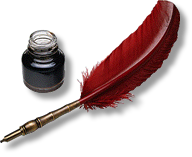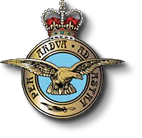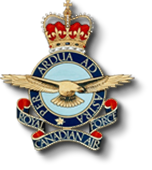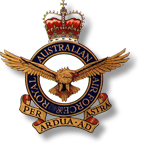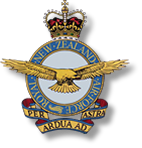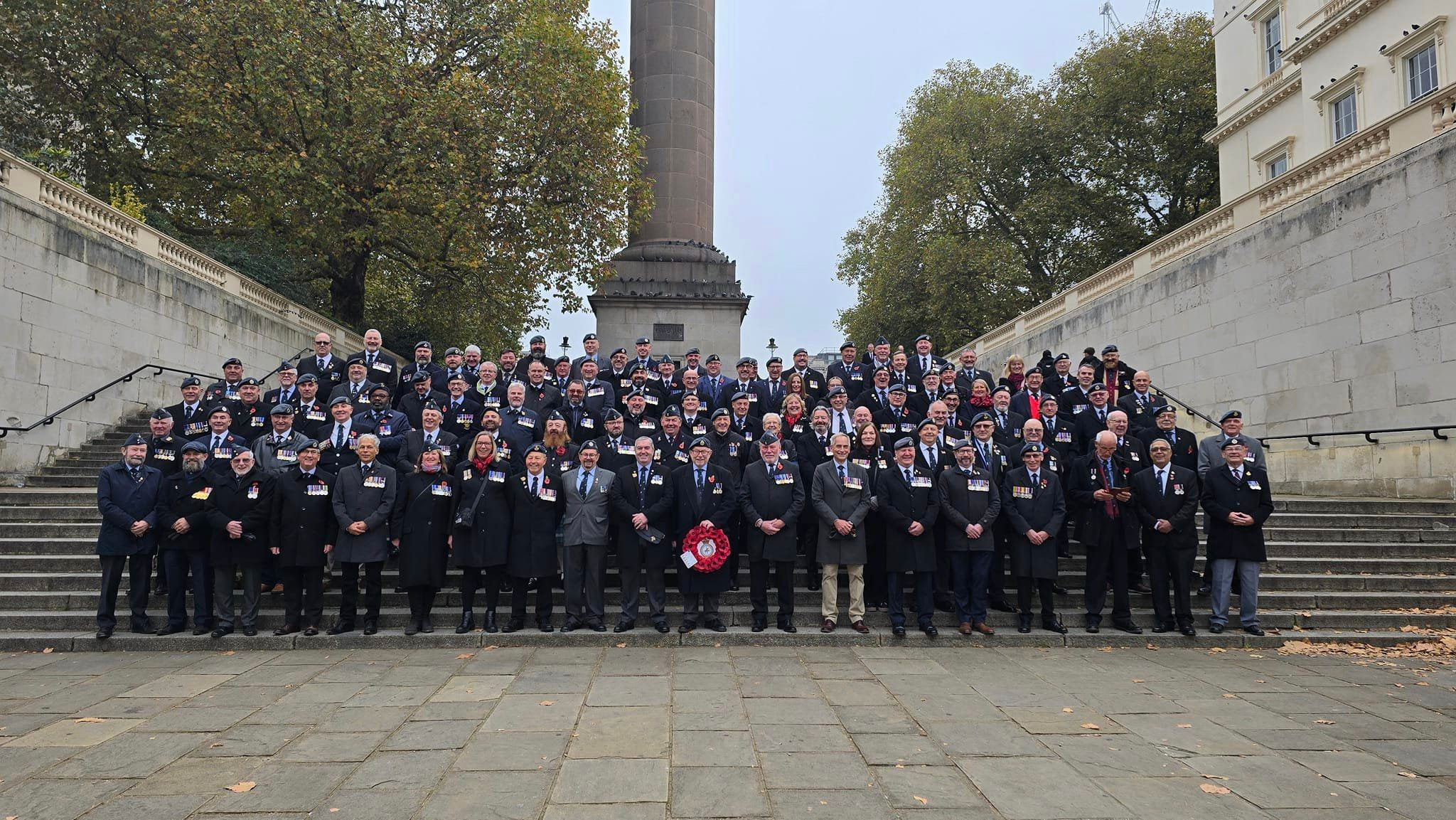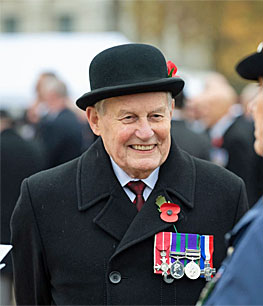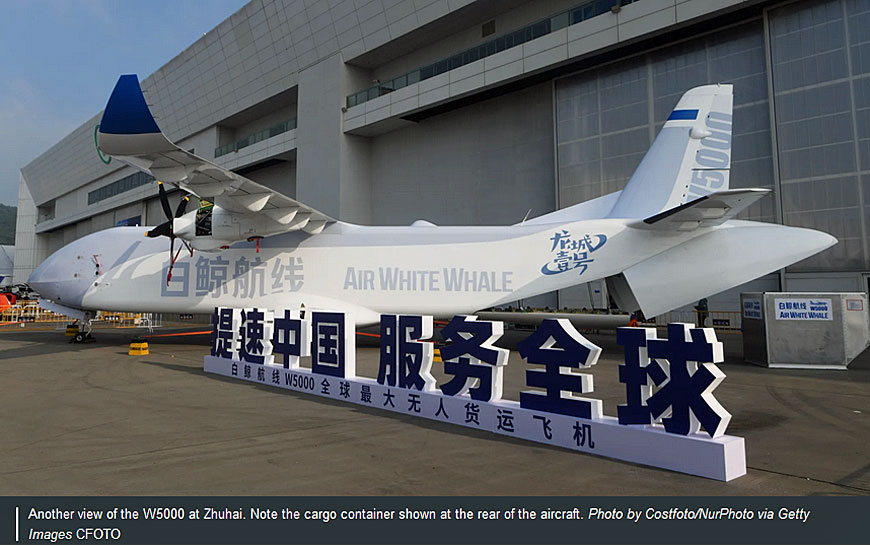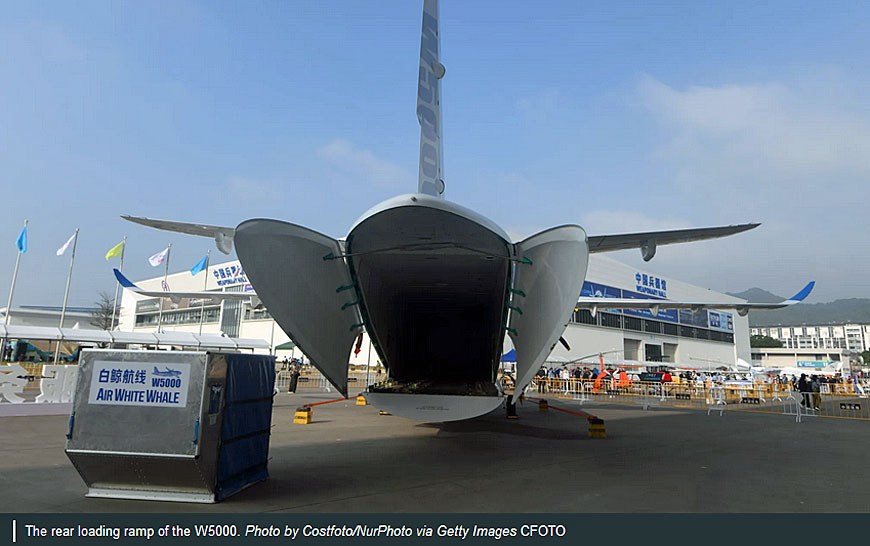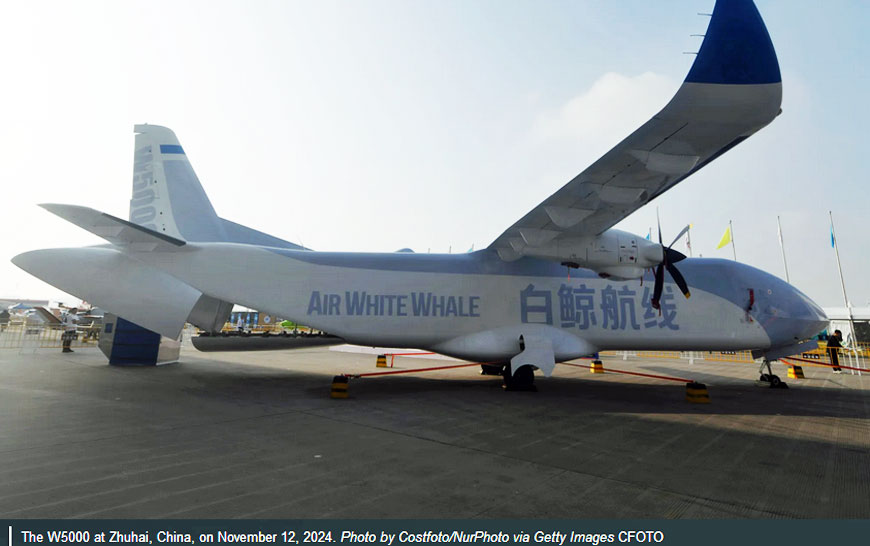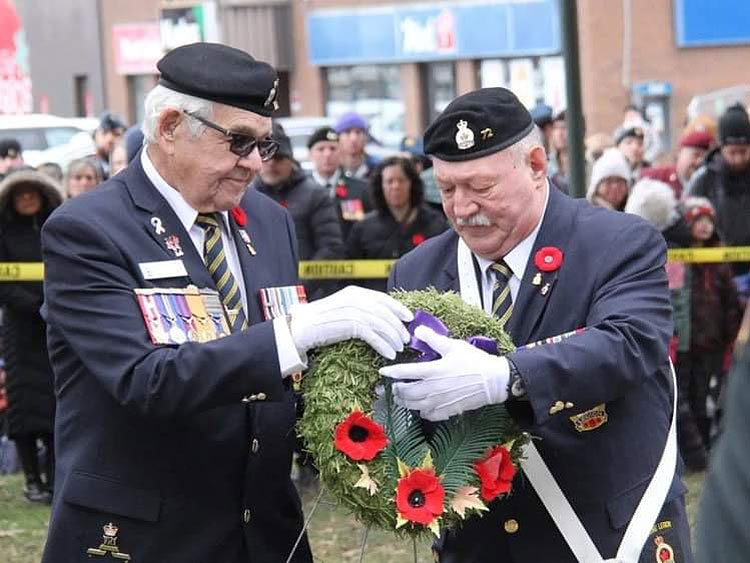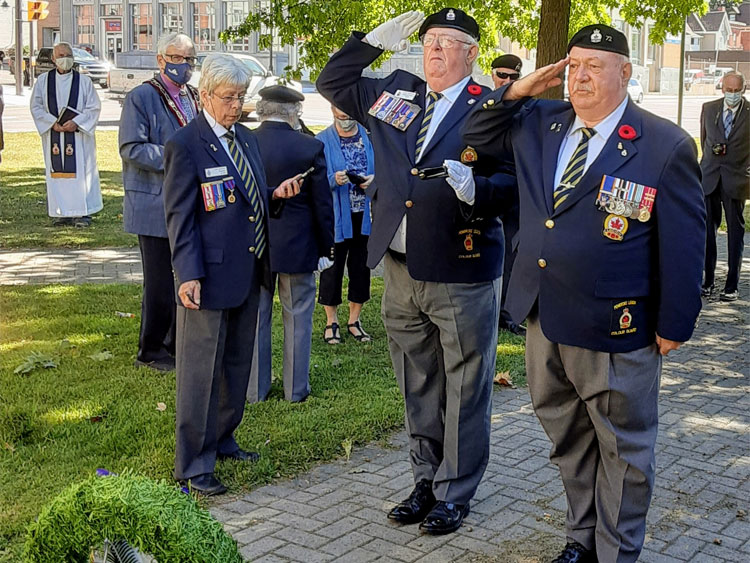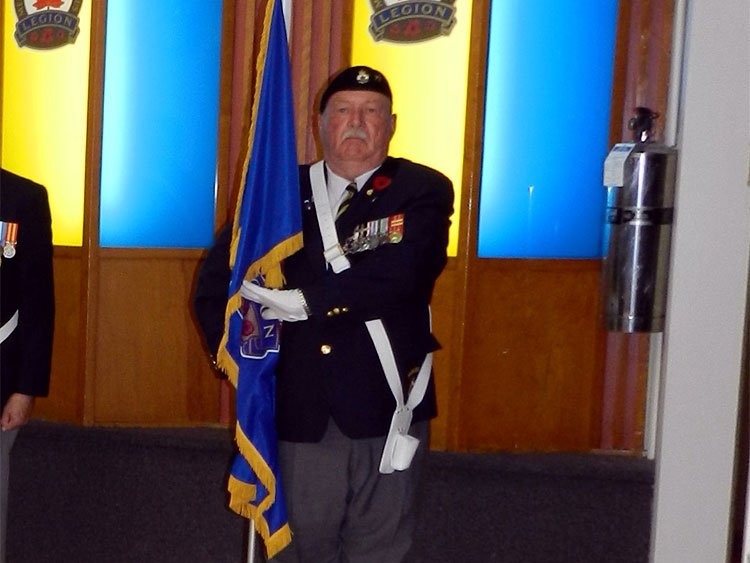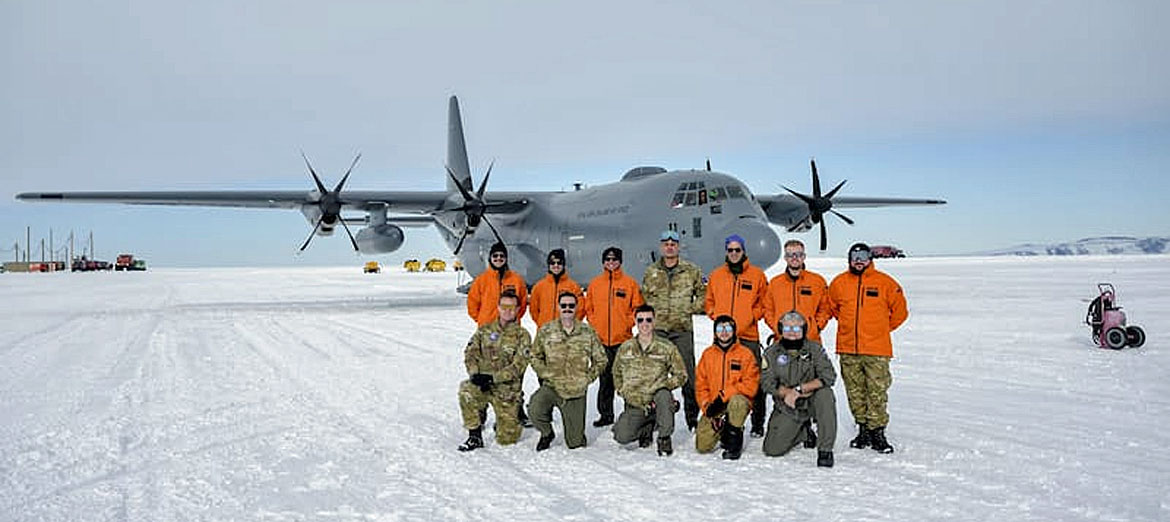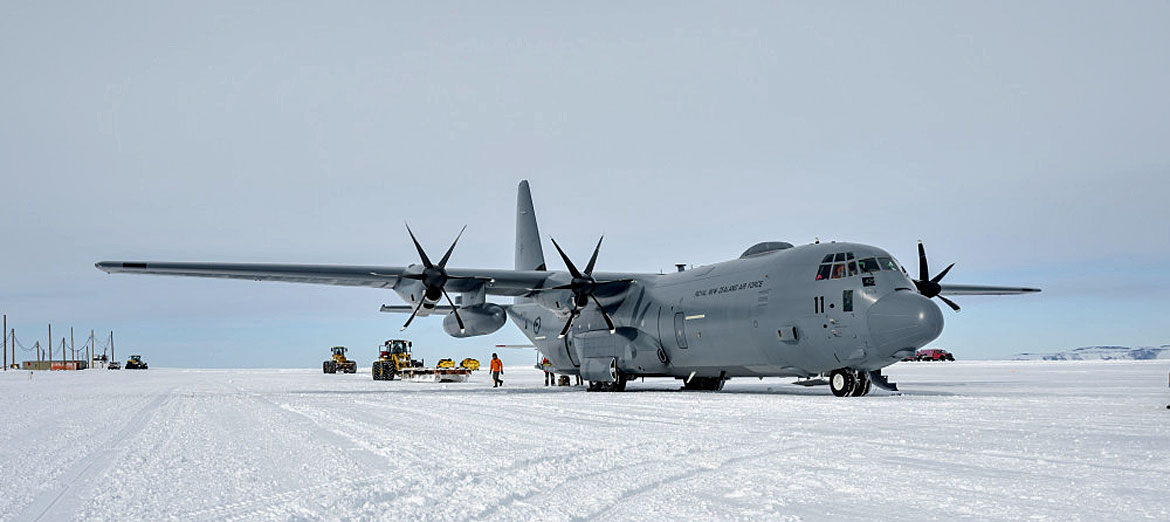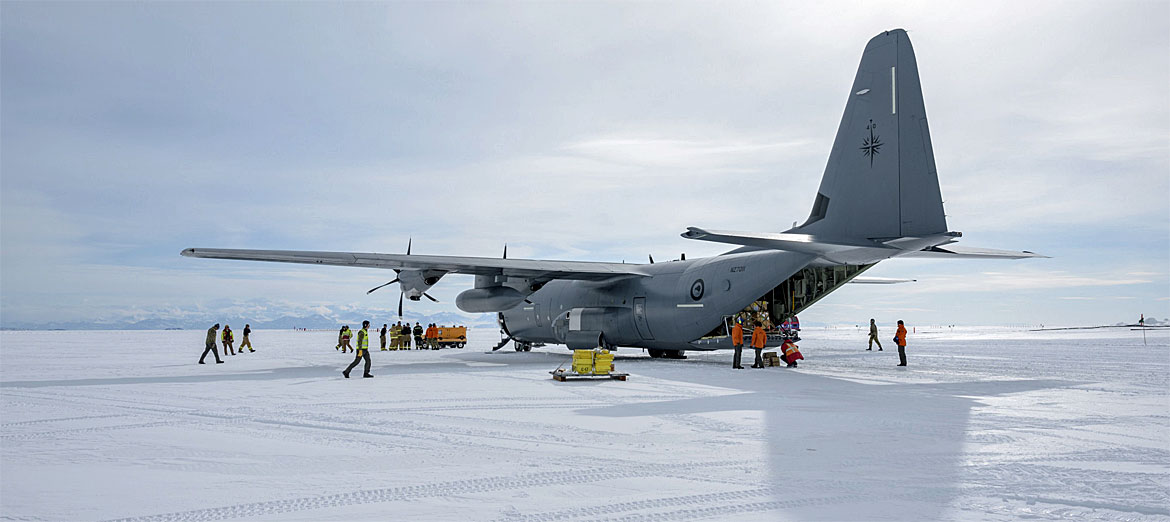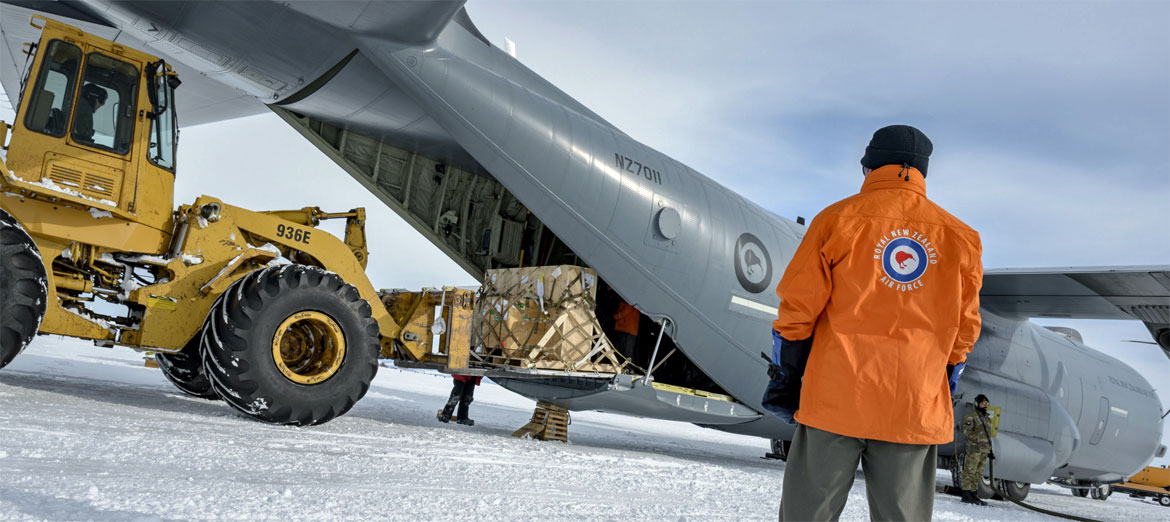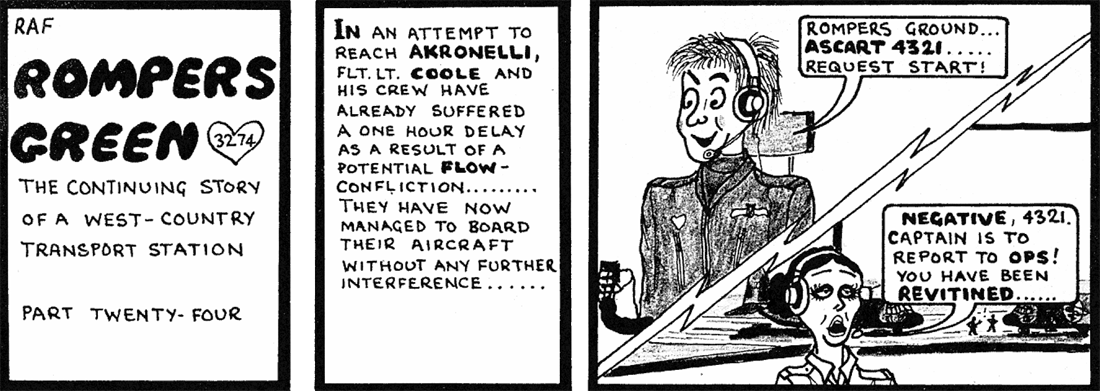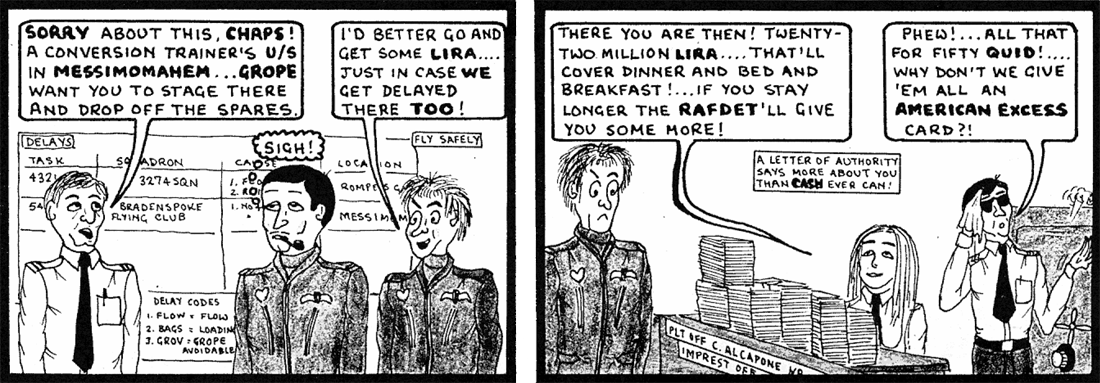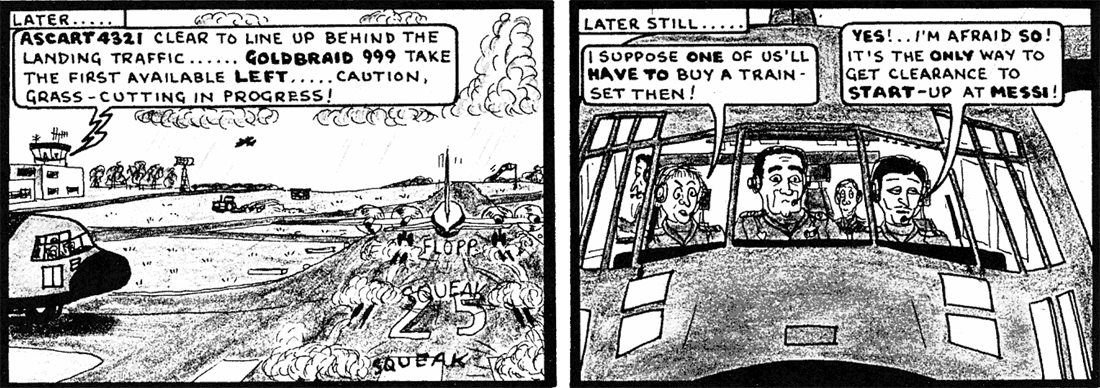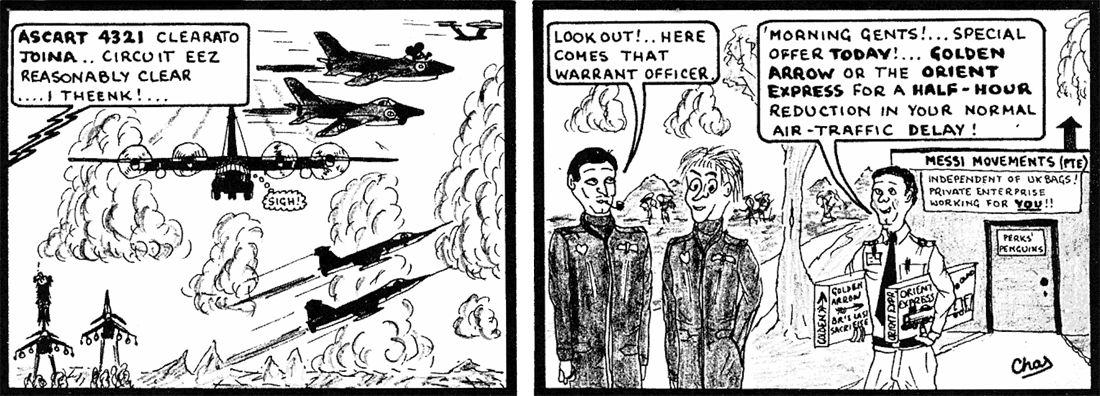
Atlas A400M Celebrates 10 years of unmatched service and capability
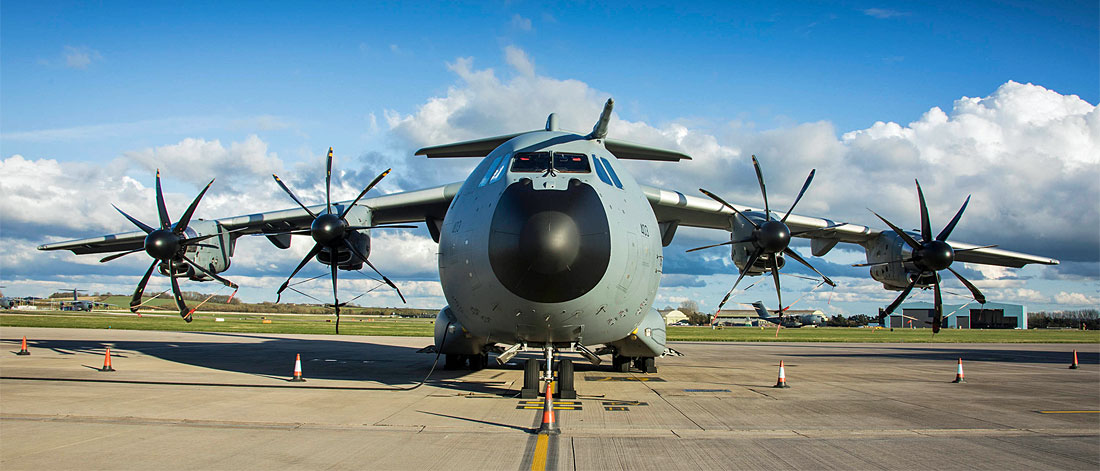
RAF Brize Norton marks the 10th anniversary since delivery of the first RAF Atlas C Mk.1 (A400M) transport aircraft.
Atlas has been a game-changer for military operations worldwide.
From natural disaster relief to pandemic response, Atlas has played a crucial role in
delivering life-saving supplies and evacuating civilians under challenging conditions.
Atlas has been a game-changer for military operations worldwide.
From natural disaster relief to pandemic response, Atlas has played a crucial role in
delivering life-saving supplies and evacuating civilians under challenging conditions.
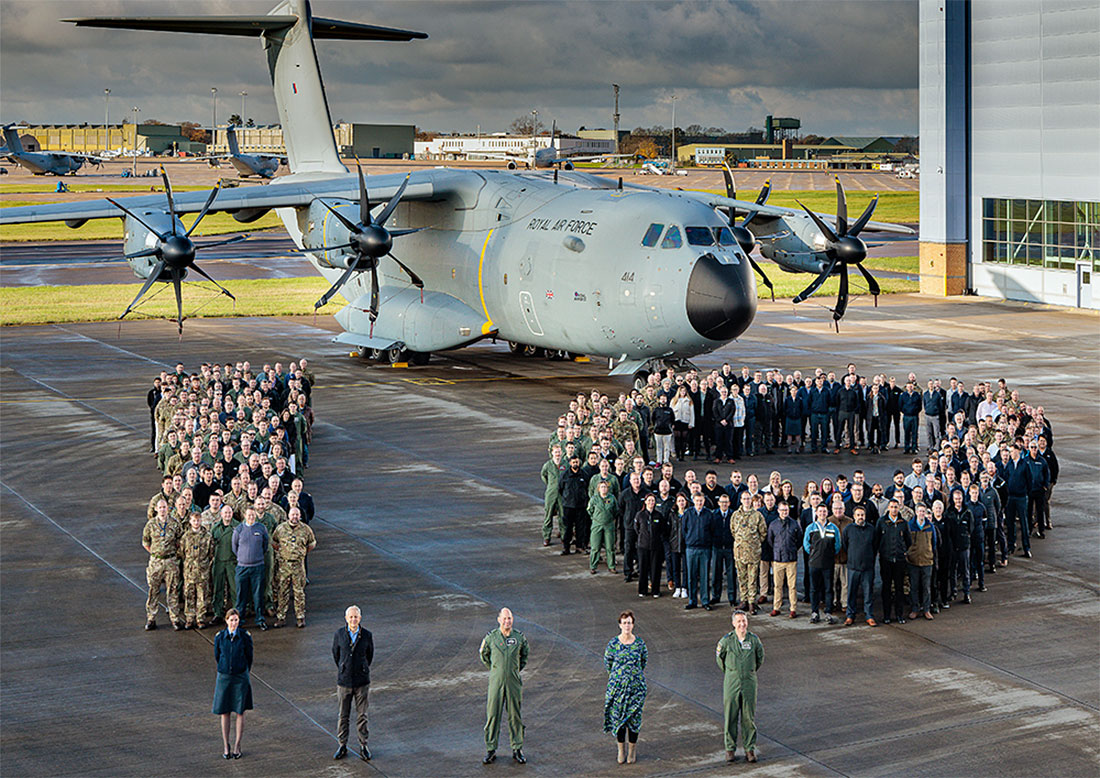
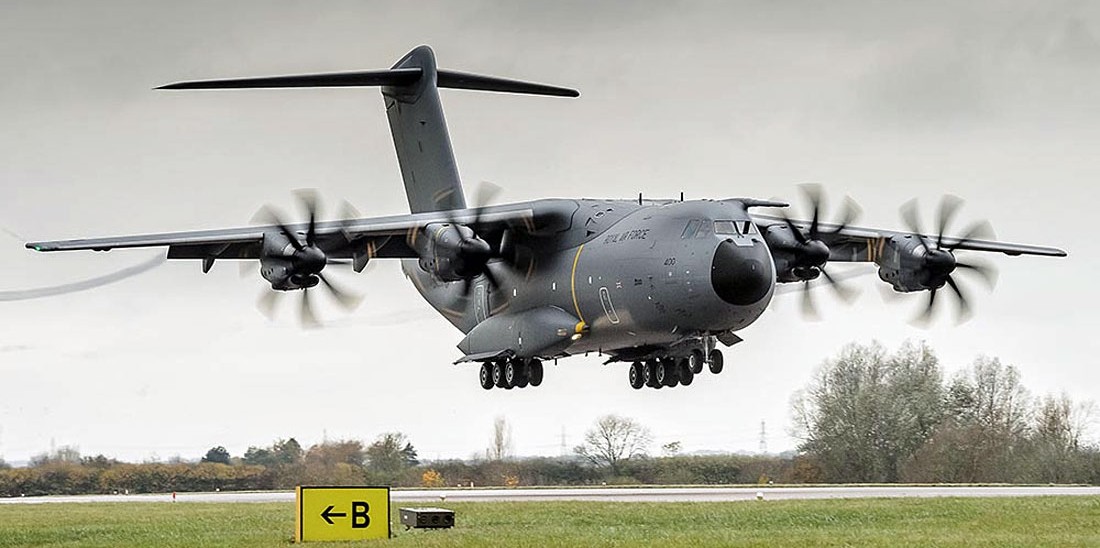
Since the first of the 22-strong fleet of aircraft was delivered to RAF Brize Norton on 17 November 2014, Atlas has repeatedly proven itself on a range of operations. It has become a vital asset to armed forces across the globe, demonstrating unprecedented performance, adaptability, and resilience in support of military and humanitarian missions alike.
Atlas has excelled during relief operations in the Caribbean and contributed fully during the military response to COVID, transporting patients, equipment and vaccines. It played a pivotal role in the evacuation of entitled personnel from Afghanistan and Sudan, and most recently delivered supplies by air drop in Gaza.
Atlas has excelled during relief operations in the Caribbean and contributed fully during the military response to COVID, transporting patients, equipment and vaccines. It played a pivotal role in the evacuation of entitled personnel from Afghanistan and Sudan, and most recently delivered supplies by air drop in Gaza.
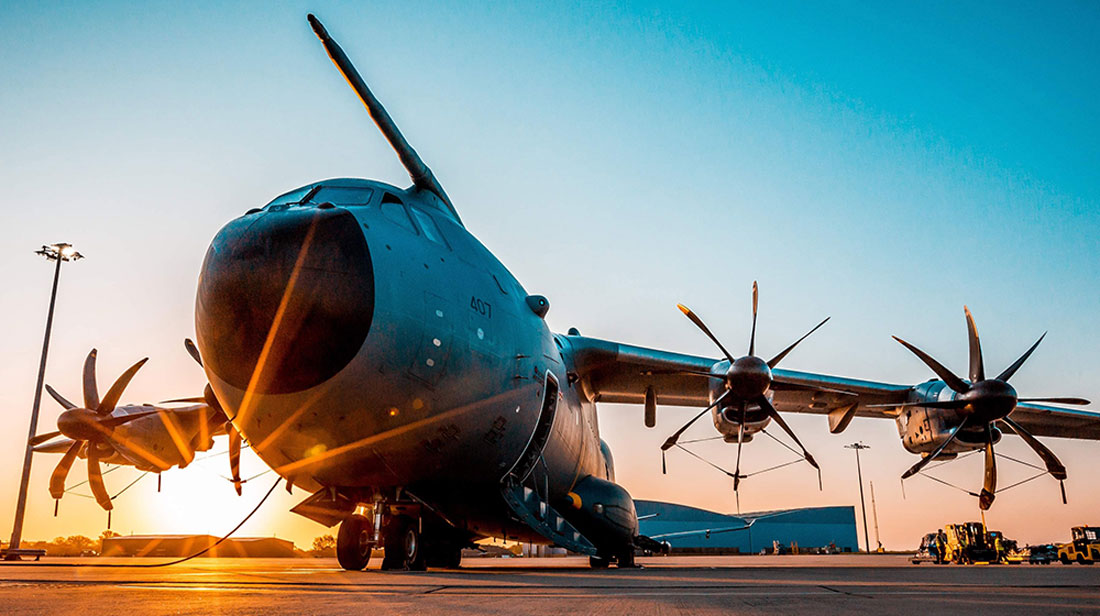
Operated by four Squadrons (XXIV, 30, LXX and 206) at RAF Brize Norton, an Atlas is also based in the Falkland Islands providing Maritime Reconnaissance, Search and Rescue, and Medical Evacuation cover in the South Atlantic. With the benefit of air-air refuelling Atlas can also airdrop supplies in Antarctica.
An A400M Atlas parked overnight in Greenland
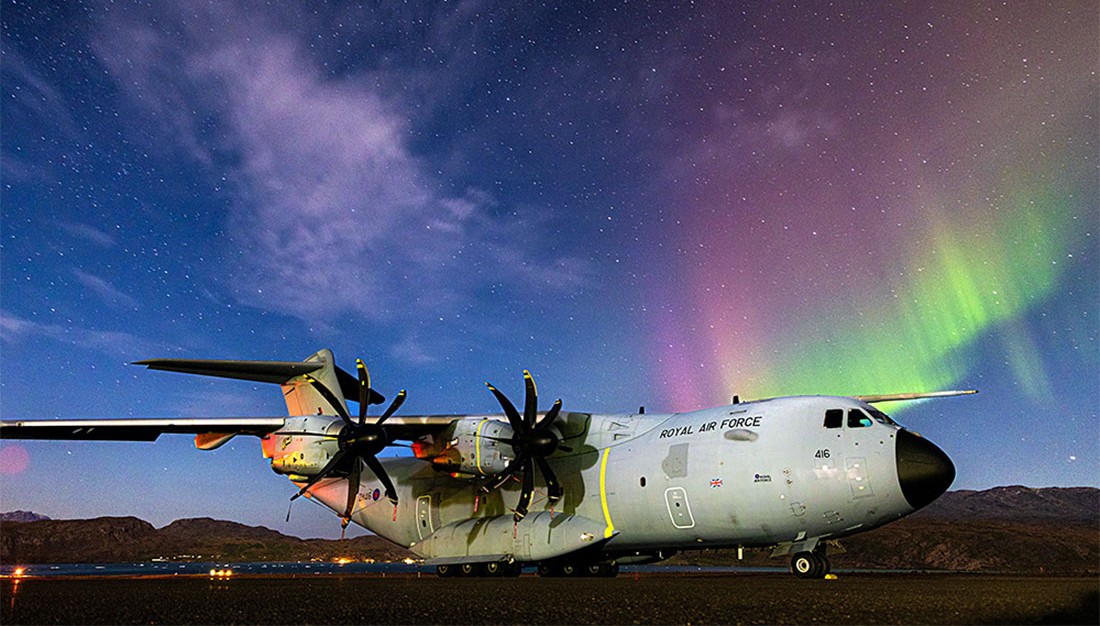
Last year an RAF Atlas also carried out the longest-ever flight of the type flying non-stop for 20½-hours from RAF Brize Norton to Guam in the Pacific.
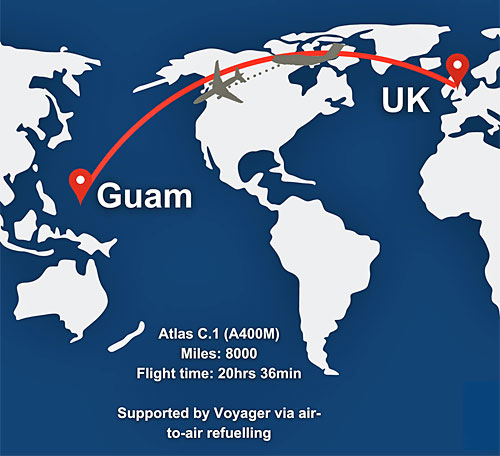
Graphic: A stylised map showing the route of the Atlas and the Voyager air to air refuelling aircraft enroute from RAF Brize Norton to Guam. Text on the map gives details of the flight, saying, 'Atlas C.1 (A400M) - Miles: 8000 - Flight Time: 20 hours 36 minutes - Supported by Voyager via air-to-air refuelling.
Commander Air Wing, RAF Brize Norton, Group Captain McIntyre said: “The Atlas has consistently demonstrated superior strategic capabilities and versatility for the many challenging missions faced by the RAF. Its range, altitude, speed, payload and tactical performance has proven invaluable in humanitarian missions over the past 10 years, including the Caribbean, Afghanistan, Sudan, Middle-East, not to mention protecting Europe’s Eastern flank and life-saving rescue missions in the South Atlantic.”
Commander Air Wing, RAF Brize Norton, Group Captain McIntyre said: “The Atlas has consistently demonstrated superior strategic capabilities and versatility for the many challenging missions faced by the RAF. Its range, altitude, speed, payload and tactical performance has proven invaluable in humanitarian missions over the past 10 years, including the Caribbean, Afghanistan, Sudan, Middle-East, not to mention protecting Europe’s Eastern flank and life-saving rescue missions in the South Atlantic.”
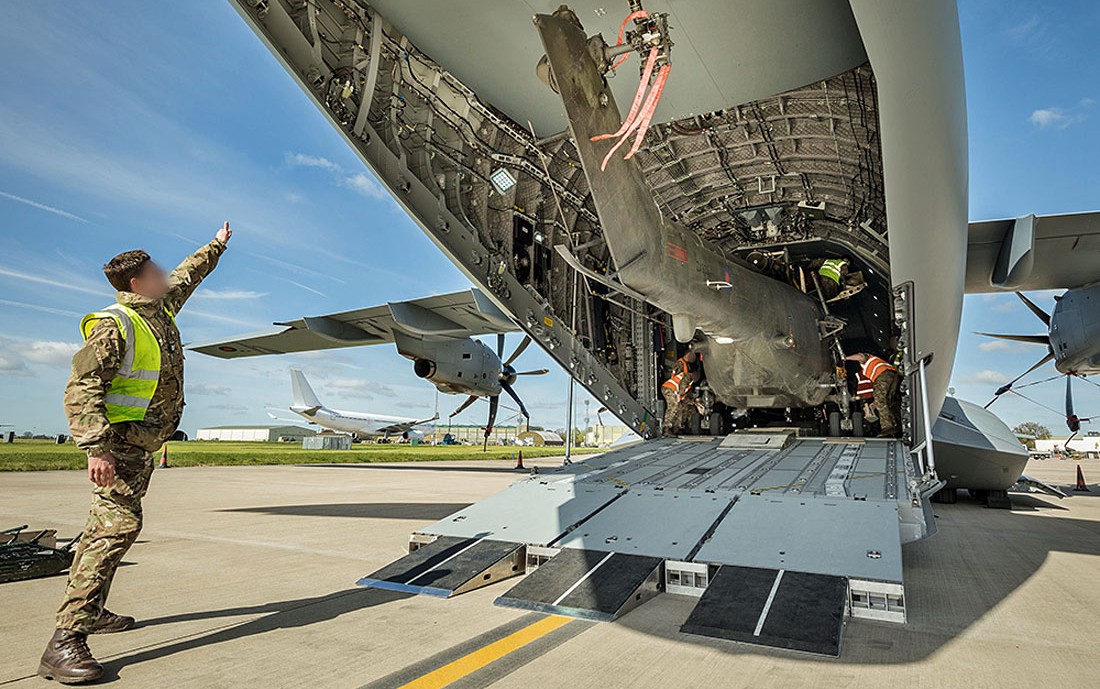
A RAF Puma helicopter being loaded onto an Atlas aircraft at RAF Brize Norton
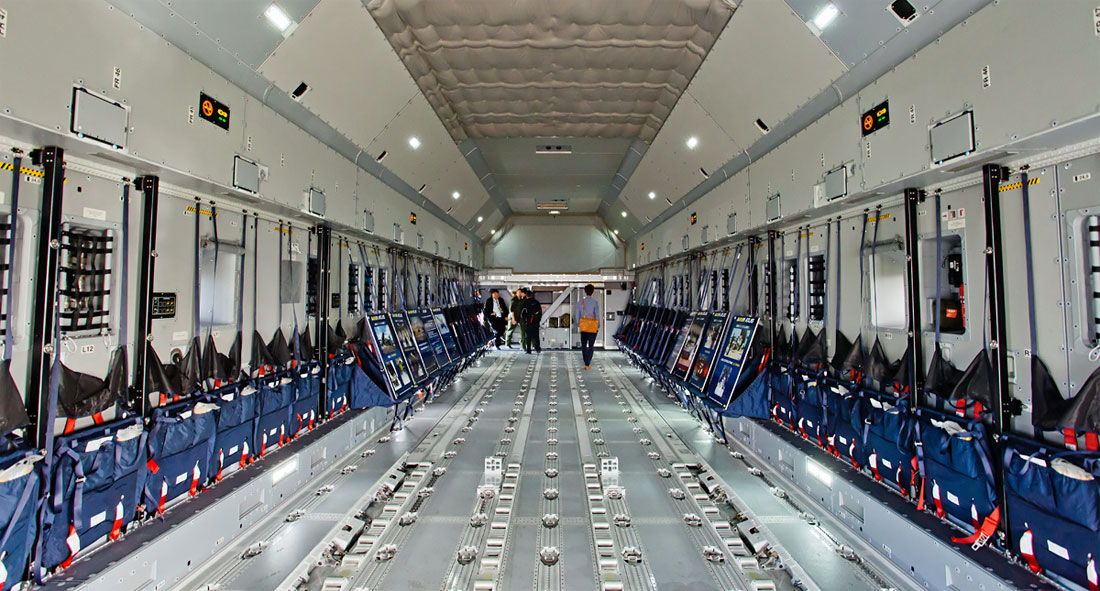
The Atlas is a four-engine turboprop aircraft that can deliver 37 tonnes of cargo over long distances, reach challenging, remote locations, and operate from short, unpaved runways, It has proven indispensable for critical operations in diverse environments. To date, the A400M has logged over 200,000 flight hours, underscoring its reliability and indispensability in missions ranging from combat support to disaster relief.
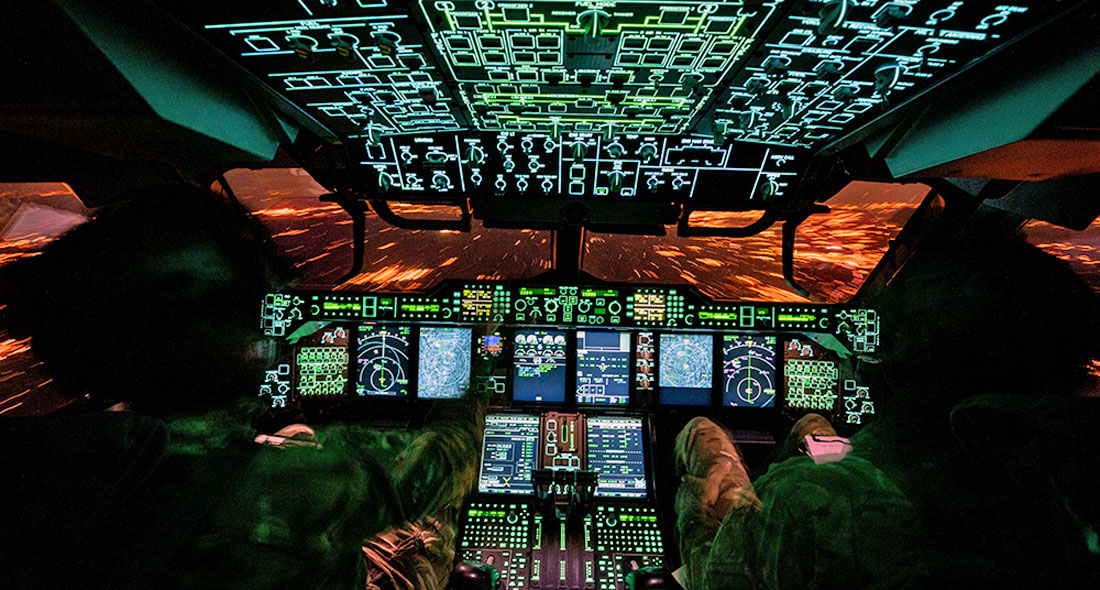
Atlas has advanced avionics, fly-by-wire controls, and a fully digital cockpit, allowing for efficient operations, precision navigation, and reduced pilot workload. It has exceptional short field performance enabling it to operate from short un-prepared as well as semi-prepared strips, all achievable whilst utilising night vision goggles.
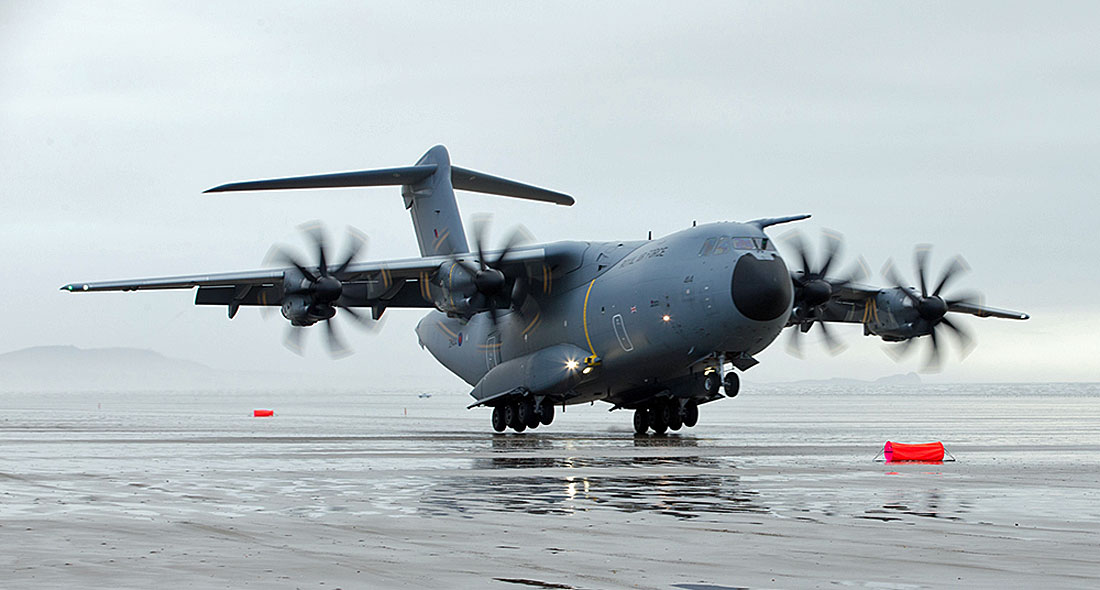
Atlas is able to operate from short un-prepared, as well as semi-prepared, strips, day and night.

From: David Powell, Princes Risborough, Bucks
Subject: Remembrance Sunday
Hello Tony,
Subject: Remembrance Sunday
Hello Tony,

RAF Ex-Movers March on Whitehall

This year a total of 107 ex-RAF Movers marched past the Cenotaph on Whitehall in London on Remembrance Sunday.
(To see full-sized click on the image above)
(To see full-sized click on the image above)
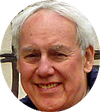
Here is a photo of me on Remembrance Sunday, 10th November at 13.30 (check the clock!) remembering colleagues past and present. Three in particular: Bob Turner, Jock McKay and Bill Jacobs.
Bob had saved my life in 1968 when I accidentally drank the CTC used to clean an Exercise White Board in Malta in 68 in mistake for lemonade - leading to the memorable line when I came round the following morning in Bighi Hospital: we don't know what the cure is you're the first live one we've had. Bob's quick thinking cure was to have passed me a pint bottle of milk (it was mid morning!) as a chaser.
The other two characters were very real connections to WW2. When I was allowed to join F Team at Abingdon in 1967, Jock, now a Flt Lt mover, ran the UKMAMS ops room. He had joined the RAF in 1939, initially as aircrew, flying as the gunner on a Coastal Command Vickers Wildebeest.
Sqn Ldr Bill Jacobs was the first OC of the very new UKMAMS. Another WW2 survivor, he had served in India and Burma. I never learned the details of this period of his service. I think he had been an aircraft mechanic at forward strips. He never talked about it. But, one perhaps unsurprising consequence was that he still suffered terrible nightmares. These were all too apparent on the occasional exercises when we deployed as a squadron, especially under tented field conditions.
Sue took the photo when I had just come back from a cold and wet partially outdoor memorial service. The large malt was strictly medicinal, but well timed.
Stay safe and have fun!
David
Bob had saved my life in 1968 when I accidentally drank the CTC used to clean an Exercise White Board in Malta in 68 in mistake for lemonade - leading to the memorable line when I came round the following morning in Bighi Hospital: we don't know what the cure is you're the first live one we've had. Bob's quick thinking cure was to have passed me a pint bottle of milk (it was mid morning!) as a chaser.
The other two characters were very real connections to WW2. When I was allowed to join F Team at Abingdon in 1967, Jock, now a Flt Lt mover, ran the UKMAMS ops room. He had joined the RAF in 1939, initially as aircrew, flying as the gunner on a Coastal Command Vickers Wildebeest.
Sqn Ldr Bill Jacobs was the first OC of the very new UKMAMS. Another WW2 survivor, he had served in India and Burma. I never learned the details of this period of his service. I think he had been an aircraft mechanic at forward strips. He never talked about it. But, one perhaps unsurprising consequence was that he still suffered terrible nightmares. These were all too apparent on the occasional exercises when we deployed as a squadron, especially under tented field conditions.
Sue took the photo when I had just come back from a cold and wet partially outdoor memorial service. The large malt was strictly medicinal, but well timed.
Stay safe and have fun!
David
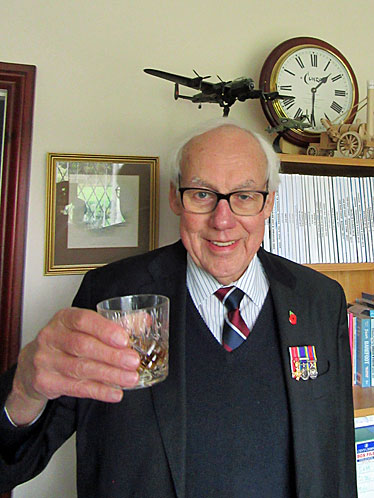

From: Mick Craner, Yeovil, Somerset
Subject: RE: UKMAMS OBA OBB #103124
Hello Tony,
Many thanks for all your efforts on our behalf. I go back to "Aircraft Difficult to Load".
Regarding the text submitted by David Powell and the closure of RAF Sharjah. I was concerned that the two police dogs were put down when they could have been kennelled and moved to another camp, or brought back to the UK to face six months quarantine.
I remember waiting in Gan for a Hercules to continue on to Changi. On board was a large cage containing three search and rescue Labradors. A notice on the cage said “This cage must not be opened until destination”. The Dogs appeared to be very friendly, so I decided to take them for a walk on the airfield. Three long pieces of lashing tape made good leads, they had a good twenty minutes relieving themselves and rolling in the grass. I often wonder what happened to these three lovely dogs? Probably disposed off when they had completed their search and rescue duties?
Cheers,
Mick Craner
Subject: RE: UKMAMS OBA OBB #103124
Hello Tony,
Many thanks for all your efforts on our behalf. I go back to "Aircraft Difficult to Load".
Regarding the text submitted by David Powell and the closure of RAF Sharjah. I was concerned that the two police dogs were put down when they could have been kennelled and moved to another camp, or brought back to the UK to face six months quarantine.
I remember waiting in Gan for a Hercules to continue on to Changi. On board was a large cage containing three search and rescue Labradors. A notice on the cage said “This cage must not be opened until destination”. The Dogs appeared to be very friendly, so I decided to take them for a walk on the airfield. Three long pieces of lashing tape made good leads, they had a good twenty minutes relieving themselves and rolling in the grass. I often wonder what happened to these three lovely dogs? Probably disposed off when they had completed their search and rescue duties?
Cheers,
Mick Craner
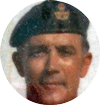

From: George Graves, Carlisle, Cumbria
Subject: Air Movements course
Hi Tony.
Here is my movements course photo which was at Abingdon in 1966.
Subject: Air Movements course
Hi Tony.
Here is my movements course photo which was at Abingdon in 1966.
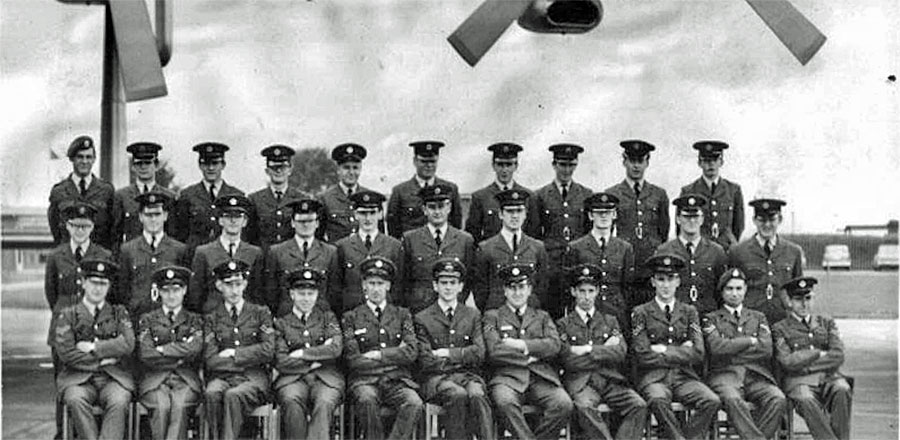
Back SAC Foster, SAC Edwards, SAC Evans, SAC Simpson, SAC Porter, SAC Oldfield, SAC Paton, SAC Elliott, SAC Parsons, LAC Goldie.
Centre SAC Whittle, SAC Moore, SAC Squire, SAC Hubbard, SAC Marshall, LAC Clarke, LAC Fitzpatrick, LAC McVeigh, SAC Hepworth, SAC Timmis.
Front Cpl Tasker, Cpl Brown, Cpl Husband, Cpl Morris, Sgt Bothery, FG Off Hyland, Sgt Titmouse, Cpl Bumford, Cpl Graves, Cpl Harper, Cpl Hill.
Centre SAC Whittle, SAC Moore, SAC Squire, SAC Hubbard, SAC Marshall, LAC Clarke, LAC Fitzpatrick, LAC McVeigh, SAC Hepworth, SAC Timmis.
Front Cpl Tasker, Cpl Brown, Cpl Husband, Cpl Morris, Sgt Bothery, FG Off Hyland, Sgt Titmouse, Cpl Bumford, Cpl Graves, Cpl Harper, Cpl Hill.
I was on parade with the veterans in Carlisle for Remembrance Sunday with my 2 medals and beret, but unfortunately I never had my photo taken.
Cheers,
George
Cheers,
George
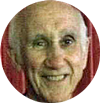

Unity in an airlift that will be remembered
Six years after they first sent United Nations (UN) peacekeepers to South Sudan to run a level-two field hospital, hundreds of People’s Army of Vietnam medical personnel have travelled to and from South Sudan on Royal Australian Air Force C-17As. Their level-two field hospital provides intensive care to peacekeepers and refugees in the northern city of Bentiu. Their latest rotation, which departed Hanoi in late September, was the sixth deployment and the sixth time Air Force has provided strategic airlift.
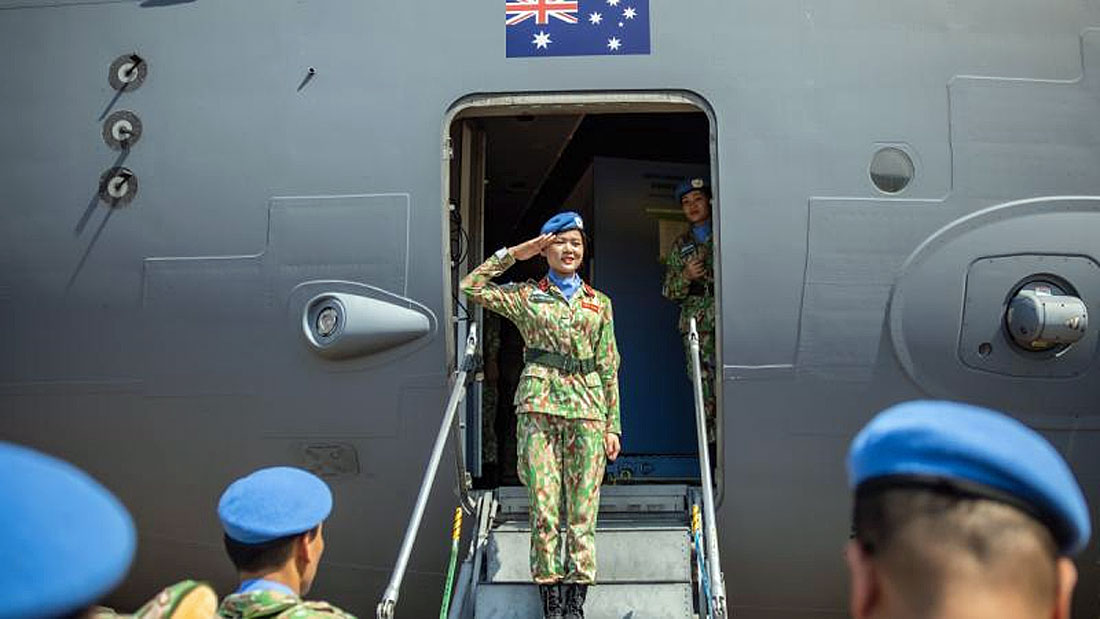
Lieutenant Do Thi Dieu Huyen, of the People’s Army of Vietnam, salutes before boarding a RAAF 36 Squadron C-17A Globemaster departing from Juba International Airport, South Sudan.
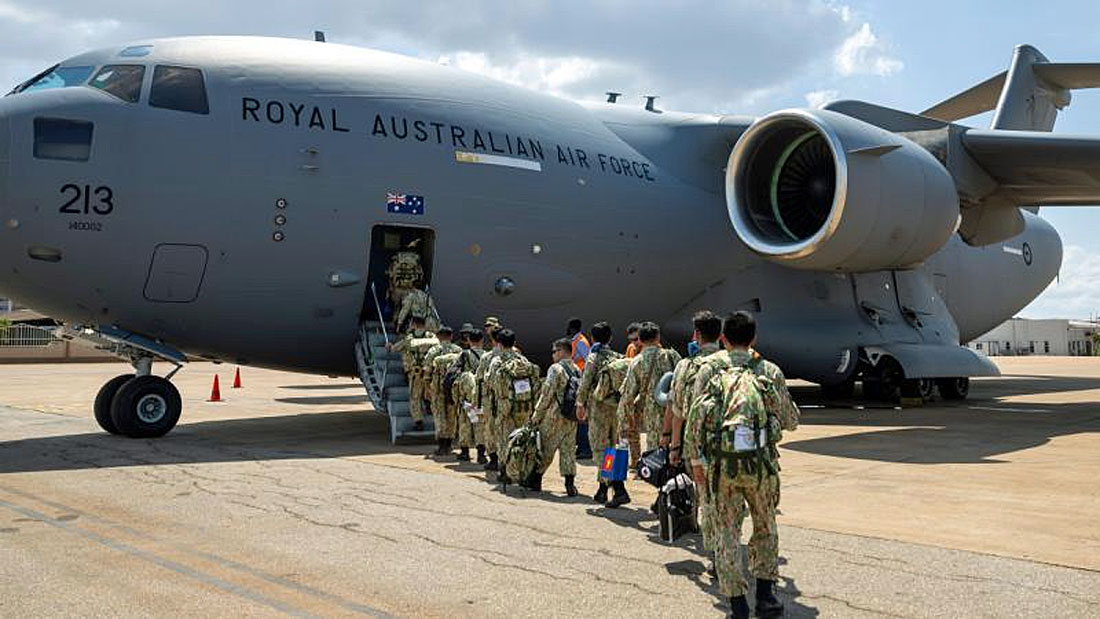
People’s Army of Vietnam UN peacekeepers board a RAAF 36 Squadron C-17A Globemaster before departing Juba International Airport, South Sudan, during a strategic airlift.
People’s Army of Vietnam UN peacekeepers prepare to take off from Juba International Airport, South Sudan, after boarding a RAAF 36 Squadron C-17A Globemaster during a strategic airlift.
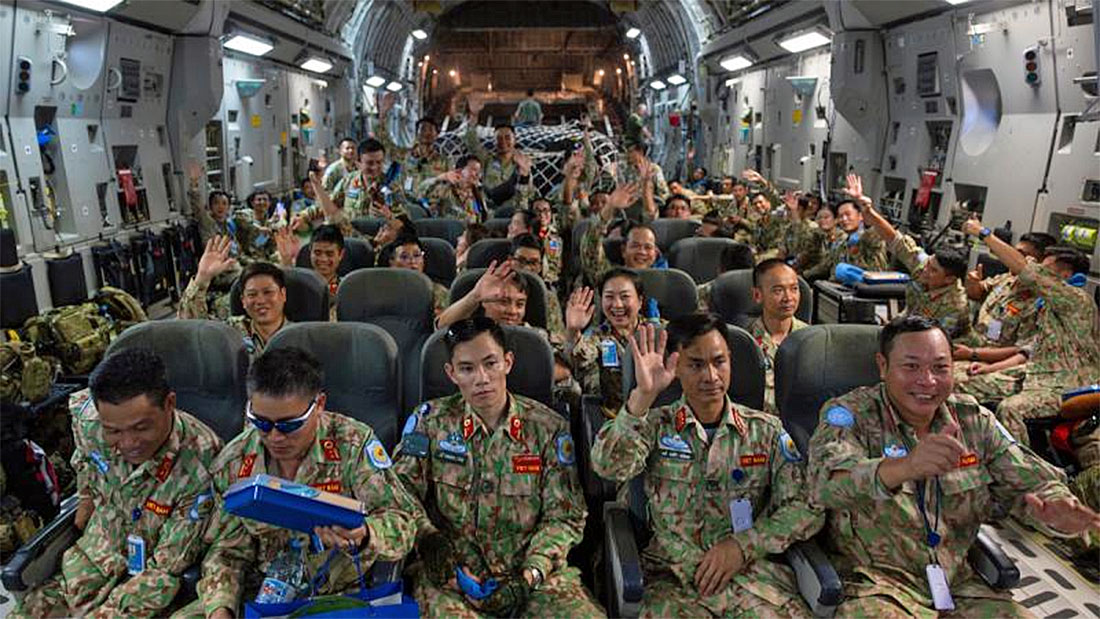
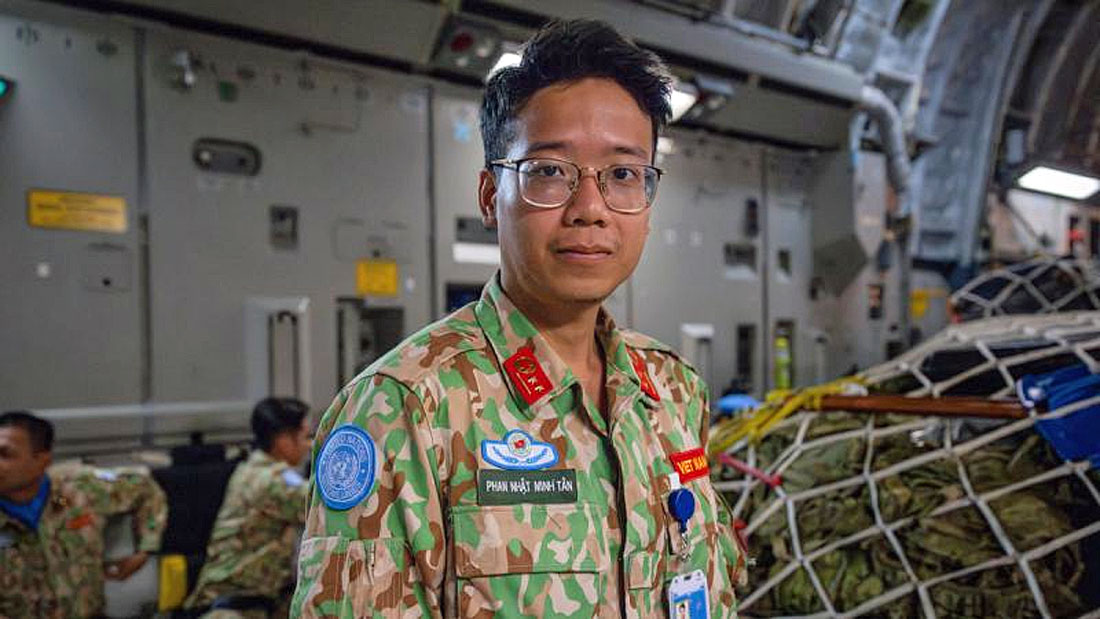
UN Peacekeeper officer Lieutenant Phan Nhat Minh Tan, of the People’s Army of Vietnam, aboard a RAAF 36 Squadron C-17A Globemaster after departing from Juba International Airport, South Sudan.
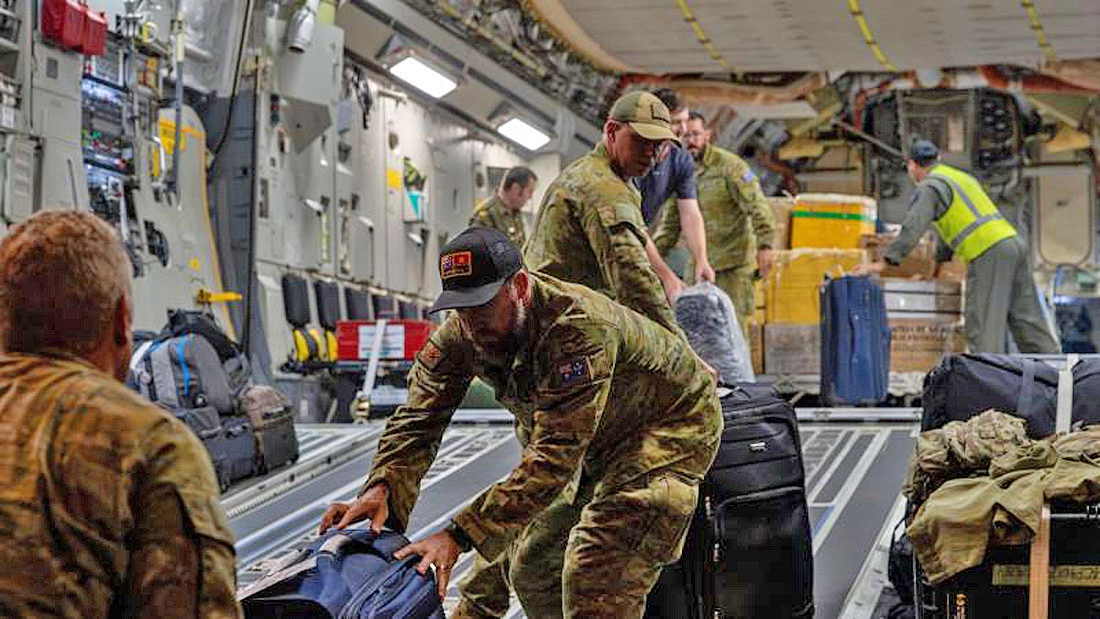
RAAF 36 Squadron aviators unload luggage belonging to People’s Army of Vietnam UN peacekeepers from a RAAF C-17A Globemaster after arriving at Tan Son Nhat airport in Ho Chi Minh City, Vietnam.
From: Brian Everett, Darlington, County Durham
Subject: Remembrance Sunday
Hi Tony,
Subject: Remembrance Sunday
Hi Tony,

Attached are some photos of this year’s parade in Whitehall. This is my 32nd year as president of the London Transport Old Comrades Association (LTOCA) and my 31st on parade.
LTOCA is the only civilian organisation with the right to march alongside the military during the Remembrance parade on Whitehall; a right granted by King George V in 1920 in recognition of the work carried out by its predecessor during World War I working alongside the military on the “front line”.
Each year a member of the LTOCA is nominated to lay a wreath, the only exception was the 100th anniversary, when the President had that privilege.
LTOCA is the only organisation on the parade with the right to lay their wreath on the Cenotaph rather than hand it over to others. Members of LTOCA are all ex-military personnel who have worked for and are now working for Transport for London (TfL).
All the best, Brian
LTOCA is the only civilian organisation with the right to march alongside the military during the Remembrance parade on Whitehall; a right granted by King George V in 1920 in recognition of the work carried out by its predecessor during World War I working alongside the military on the “front line”.
Each year a member of the LTOCA is nominated to lay a wreath, the only exception was the 100th anniversary, when the President had that privilege.
LTOCA is the only organisation on the parade with the right to lay their wreath on the Cenotaph rather than hand it over to others. Members of LTOCA are all ex-military personnel who have worked for and are now working for Transport for London (TfL).
All the best, Brian
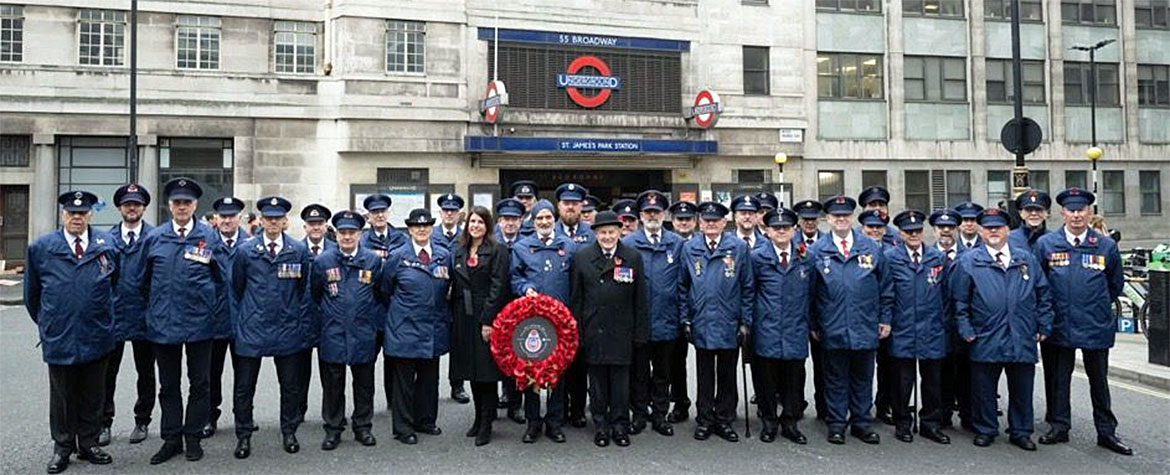
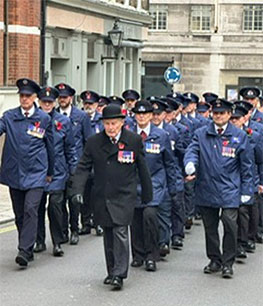

From: Peter Clayton, Wroughton, Wilts
Subject: Remembrance Sunday
Hi Tony,
Subject: Remembrance Sunday
Hi Tony,

I attach a photo of me wearing my Dad's medals at this year's Remembrance Parade in London. I'm told that his set of medals is quite unique in that they are from 3 Monarchs.
On this year's list of Movers that passed away in the last year is Trevor Jenner. I have now found out almost certainly that this was my friend Trevor Oakley-Jenner who was on UKMAMS at Lyneham during the late 70's.
He was only 71 years old in August when he passed away, leaving his wife Lorraine. They lived in Carlisle. I cannot find out who gave the information about Trevor Jenner, but I think they must be the same person.
Regards Peter
On this year's list of Movers that passed away in the last year is Trevor Jenner. I have now found out almost certainly that this was my friend Trevor Oakley-Jenner who was on UKMAMS at Lyneham during the late 70's.
He was only 71 years old in August when he passed away, leaving his wife Lorraine. They lived in Carlisle. I cannot find out who gave the information about Trevor Jenner, but I think they must be the same person.
Regards Peter
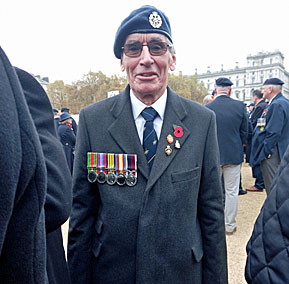

China’s New W5000 Cargo Drone is the Biggest Yet
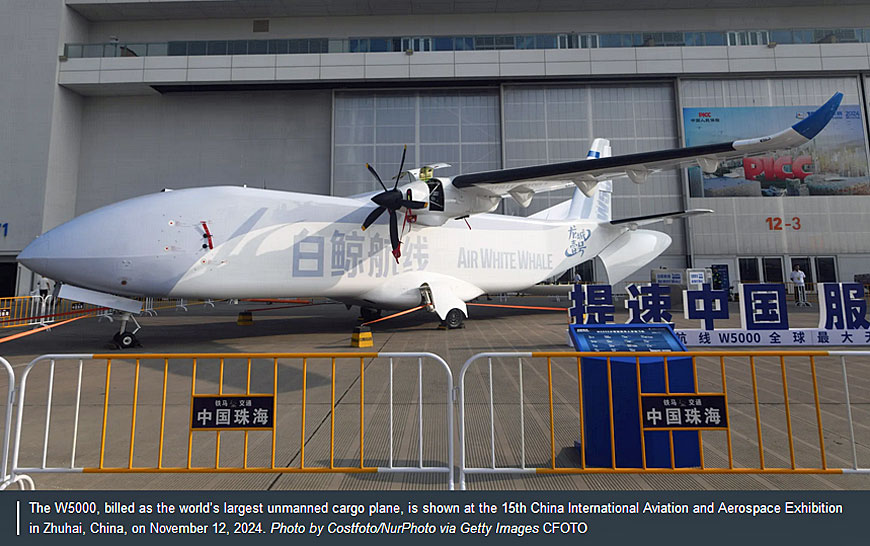
With drones growing larger in size and ever more capable, China’s expanding portfolio of uncrewed cargo aircraft has major military implications.
China’s development of uncrewed cargo aircraft continues apace, with the ongoing Airshow China including the first public appearance of the W5000, the biggest that we’ve seen so far, as well as a full-size mockup of one that can also operate from water, and a new concept for an air-launched cargo drone. China now has a multitude of cargo drones in development or under flight test, and beyond their clear civilian applications, their potential utility for helping maintain military logistics networks is very clear. The various cargo drones are displayed at Airshow China, also known as the China International Aviation & Aerospace Exhibition, in Zhuhai. The event officially opened today and runs until November 17.
The big W5000 is from the Air White Whale company. This uncrewed cargo aircraft was unveiled last month when the first example rolled off the production line in the eastern Chinese city of Changzhou. A real example of the drone is part of the static display at Airshow China. The W5000 is named for its payload of 5,000 kilograms — 11,023 pounds — and is said to have a maximum range of 2,600 kilometers (1,616 miles), with a cruising speed of up to 526 km/h (284 knots). The maximum takeoff weight of the drone is 10,800 kilograms (23,810 pounds). Reportedly, the high-wing, twin-engine W5000 is powered by AEP-100 turboprops, which is produced by Aero Engine Corporation of China.
According to Air White Whale, the W5000 is compatible with standard cargo pallets, which can be loaded and unloaded via a rear ramp and clamshell-type doors in the rear fuselage. The drone is designed to be able to use smaller general aviation airports as well as commercial aviation airports.
The ground control system for the W5000 is said to allow a single operator to monitor up to five of the drones simultaneously.
The unveiling ceremony for the W5000 on October 18 was attended by executives from different cargo and logistics firms, including JD.com, China Eastern Airlines Logistics, as well as China Post, suggesting one or more of these can be likely launch customers.
twz.com
China’s development of uncrewed cargo aircraft continues apace, with the ongoing Airshow China including the first public appearance of the W5000, the biggest that we’ve seen so far, as well as a full-size mockup of one that can also operate from water, and a new concept for an air-launched cargo drone. China now has a multitude of cargo drones in development or under flight test, and beyond their clear civilian applications, their potential utility for helping maintain military logistics networks is very clear. The various cargo drones are displayed at Airshow China, also known as the China International Aviation & Aerospace Exhibition, in Zhuhai. The event officially opened today and runs until November 17.
The big W5000 is from the Air White Whale company. This uncrewed cargo aircraft was unveiled last month when the first example rolled off the production line in the eastern Chinese city of Changzhou. A real example of the drone is part of the static display at Airshow China. The W5000 is named for its payload of 5,000 kilograms — 11,023 pounds — and is said to have a maximum range of 2,600 kilometers (1,616 miles), with a cruising speed of up to 526 km/h (284 knots). The maximum takeoff weight of the drone is 10,800 kilograms (23,810 pounds). Reportedly, the high-wing, twin-engine W5000 is powered by AEP-100 turboprops, which is produced by Aero Engine Corporation of China.
According to Air White Whale, the W5000 is compatible with standard cargo pallets, which can be loaded and unloaded via a rear ramp and clamshell-type doors in the rear fuselage. The drone is designed to be able to use smaller general aviation airports as well as commercial aviation airports.
The ground control system for the W5000 is said to allow a single operator to monitor up to five of the drones simultaneously.
The unveiling ceremony for the W5000 on October 18 was attended by executives from different cargo and logistics firms, including JD.com, China Eastern Airlines Logistics, as well as China Post, suggesting one or more of these can be likely launch customers.
twz.com

From: Budgie Baigent, Tākaka, Tasman
Subject: Remembrance Sunday
Hi Tony,
Suited and bemedaled I was, but you need good eyes to spot them both in this article from 'Golden Bay Weekly'.
Subject: Remembrance Sunday
Hi Tony,
Suited and bemedaled I was, but you need good eyes to spot them both in this article from 'Golden Bay Weekly'.

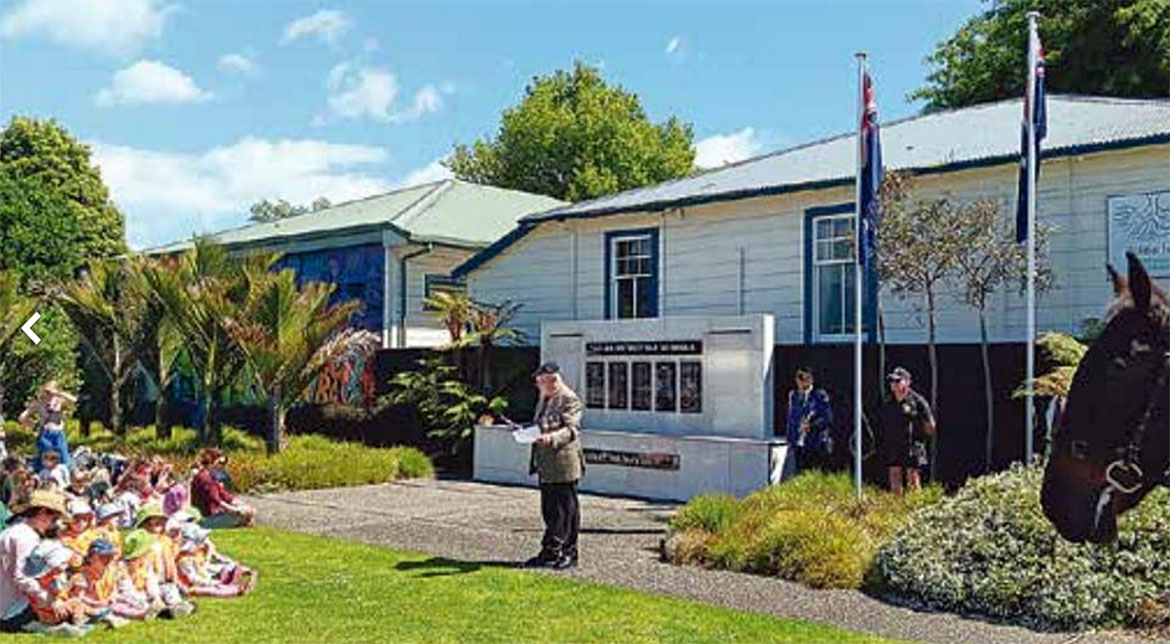
On Monday at 11am, Remembrance Day commemorations were held in Tākaka and Collingwood. At Tākaka's memorial Park, president of Golden Bay RSA, Noel Baigent (above centre), led the service which was attended by around 60 people including groups from Golden Kids Tākaka and Tākaka Primary School, plus two representatives of the Tākaka Mounted Rifles.
You do amazing work with the OBA.
Cheers, Budgie
You do amazing work with the OBA.
Cheers, Budgie

From: Len Wood, Pembroke, ON
Subject: Remembrance Sunday - and - The Traffic and Movements School
Good afternoon, Trapper.
Here are a few photos of me at Remembrance Service in Pembroke, Ontario. I am in the RCL Branch 72 Colour Guard and carry the Legion Banner. My most important responsibility, during the Remembrance Service, is dipping the legion banner during playing of the Last Post, Silence, Lament & Reville.
Subject: Remembrance Sunday - and - The Traffic and Movements School
Good afternoon, Trapper.
Here are a few photos of me at Remembrance Service in Pembroke, Ontario. I am in the RCL Branch 72 Colour Guard and carry the Legion Banner. My most important responsibility, during the Remembrance Service, is dipping the legion banner during playing of the Last Post, Silence, Lament & Reville.

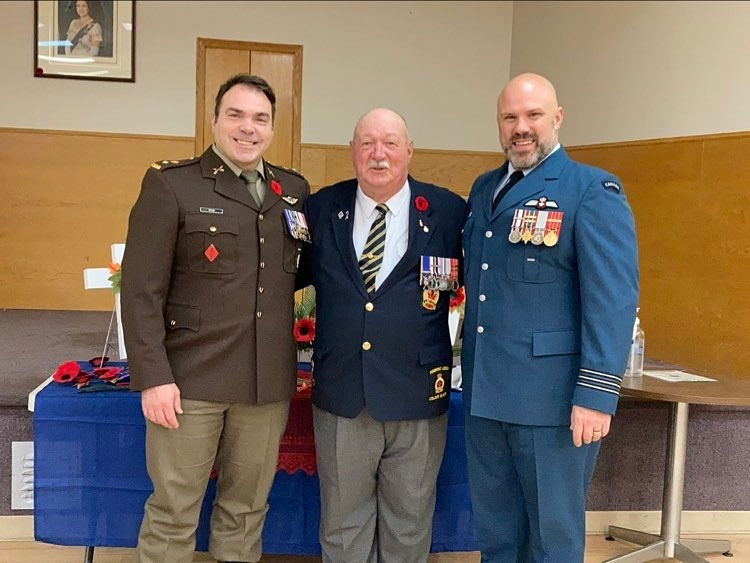
My story with regards to the Air Movements School - In 1980 I remustered from the Infantry, serving in Germany, to the Traffic Tech Trade 933. The Traffic Tech Career Manager posted me to The Canadian Forces School of Traffic and Movements (CFSTM) CFB Greisbach (Edmonton) for OJT. I was not an instructor as I was not yet a Mover. My responsibilities included making coffee, looking after the School canteen, maintaining the School's vehicles at their Air Movements mock-up, which included a CC137 (Boeing 707) Cargo door entrance and CC130 (Herc) ramp with partial floor with tie-down rings and the inventory of all the Helicopter Ops slinging equipment, pallets, tie-down devices, chains and straps, etc...
A it turned out, I was also completing amendments to EVERY MANUAL regarding the Traffic and Movements Trade (ALL MODES - F&E, CMTT, Air, Road, Rail & Sea Movement manuals, CFAO, QR&Os, IATA, ICAO etc) became my major job. This proved to be very beneficial for an infantry man when I started my Trades courses. I could move through every manual with ease and had no problems with any exam throughout my Movements career. I credit the OJT at CFSTM from Oct 1980 - April 1981 for my success with regards to Trades courses at the School. After 40 years, I was recognized as being on staff at the Traffic & Movements School formerly CFSTM and a Senior Mover in our trade sent me a Logistics School Traffic Cadre Coin - two photos front/back view of the coin attached.
A it turned out, I was also completing amendments to EVERY MANUAL regarding the Traffic and Movements Trade (ALL MODES - F&E, CMTT, Air, Road, Rail & Sea Movement manuals, CFAO, QR&Os, IATA, ICAO etc) became my major job. This proved to be very beneficial for an infantry man when I started my Trades courses. I could move through every manual with ease and had no problems with any exam throughout my Movements career. I credit the OJT at CFSTM from Oct 1980 - April 1981 for my success with regards to Trades courses at the School. After 40 years, I was recognized as being on staff at the Traffic & Movements School formerly CFSTM and a Senior Mover in our trade sent me a Logistics School Traffic Cadre Coin - two photos front/back view of the coin attached.
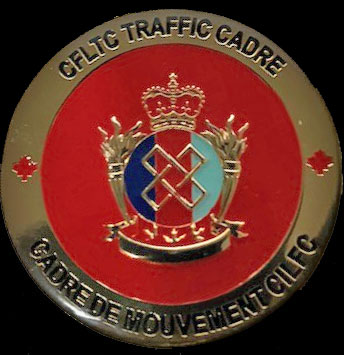
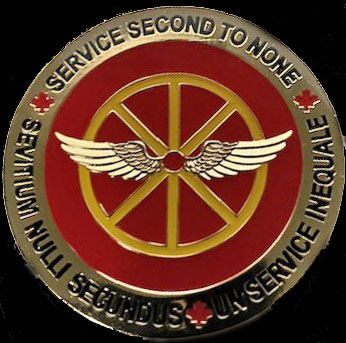
Best regards, Trapper Woody

From: Richard Gunn, York
Subject: Movements School
Hi Tony,
My career as a mover started after square bashing at RAF Kidbrooke as a surface mover, after tours at RAF Sharjah and No 1 SMU York during which time I completed the SUPP/M course and as per photo the Air Movers course. For my troubles I got posted to Lyneham which was a bit of a culture shock so I volunteered for MEAF MAMS and then moved on to being an AQM
Subject: Movements School
Hi Tony,
My career as a mover started after square bashing at RAF Kidbrooke as a surface mover, after tours at RAF Sharjah and No 1 SMU York during which time I completed the SUPP/M course and as per photo the Air Movers course. For my troubles I got posted to Lyneham which was a bit of a culture shock so I volunteered for MEAF MAMS and then moved on to being an AQM

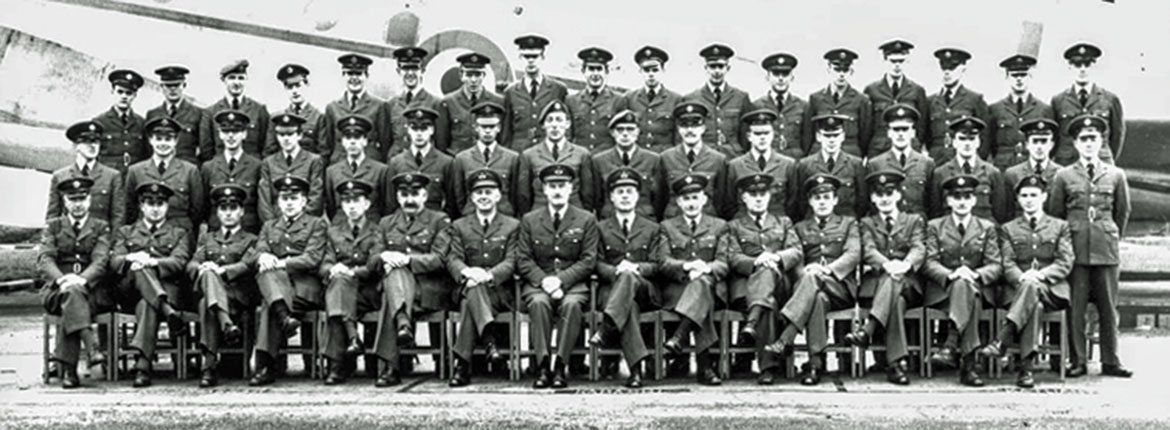
ROYAL AIR FORCE MOVEMENTS SCHOOL
No. 32 Junior Entry 14th December 1960 to 31st January 1961
No. 32 Junior Entry 14th December 1960 to 31st January 1961
Rear - AC's Baker, Hill, Craig, Lord, Coraghan, Ditchburn. Nethercott, [Illegible], Raven, Clarke, Neale, Callan, Robinson, Jenkins, Barlow, Daly, Garrard.
Centre - AC's Gale, [Illegible], Woodthorpe, SAC Fordham, AC's Andrews, Jakeman, [Illegible], Cpl's Madison, Bell, AC's Lambert, Madison, Gunn, Flumpton, Grant, Wilkinson, MacIntosh, Clulow.
Front - Cpl's [Illegible], Leader, Halls, Freece, Laverty, Hicks, FS Waltham, Flt Lt Williams, Sqn Ldr Rich, Flt Lt Davies, Cpl's Smith, Foreman, Firth, Davies.
Centre - AC's Gale, [Illegible], Woodthorpe, SAC Fordham, AC's Andrews, Jakeman, [Illegible], Cpl's Madison, Bell, AC's Lambert, Madison, Gunn, Flumpton, Grant, Wilkinson, MacIntosh, Clulow.
Front - Cpl's [Illegible], Leader, Halls, Freece, Laverty, Hicks, FS Waltham, Flt Lt Williams, Sqn Ldr Rich, Flt Lt Davies, Cpl's Smith, Foreman, Firth, Davies.

Edmonton Likely Location for Western Base for the RCAF CC-330 Husky
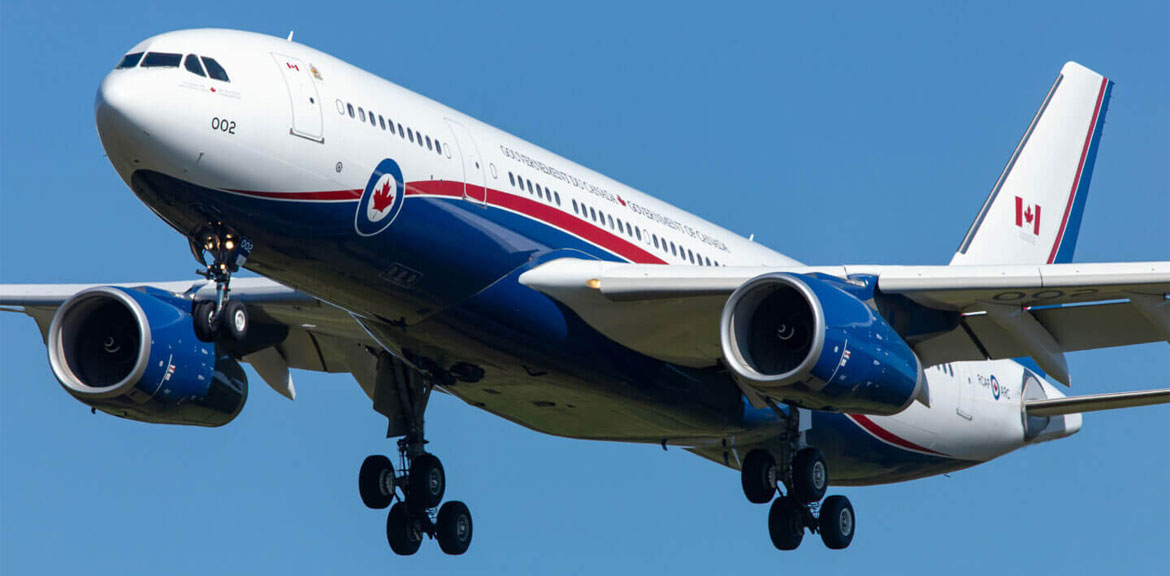
The Department of National Defence (DND) is in negotiations with the Edmonton International Airport (YEG) to formalize an agreement for the location of the new Main Operating Base-West (MOB-West) for the Royal Canadian Air Force’s (RCAF) CC-330 Husky fleet.
In March 2024, the DND confirmed 8 Wing Trenton, Ont., as its MOB-East location for the Strategic Tanker Transport Capability fleet and provided $850 million to design a two-bay hangar and upgrade the apron, runway, taxiways and other supporting infrastructure.
The department has yet to name a primary forward operating location in the North.
Under a $3.6 billion contract with Airbus Defence and Space, announced in July 2023, the RCAF is acquiring four new A330 Multi-Role Tanker Transport aircraft and will also convert four of five recently acquired used A330-200 aircraft to the MRTT configuration. The nine aircraft, designated the CC-330 Husky, are replacing the RCAF fleet of five CP-150 Polaris aircraft, two of which are configured for tanking.
The Air Force has begun receiving the CC-330s in their commercial configuration for transport missions. The first MRTT configured aircraft is expected to begin operations in 2027, and the RCAF is anticipating reaching initial operational capability for the fleet in 2028-2029. The nine Huskies will be split between the two MOB locations.
RCAF Commander, LGen Eric Kenny, said, “The CC-330 Husky will provide the RCAF with increased flexibility to fulfill a variety of air mobility missions in support of operations and training activities within Canada, as part of NORAD, its Arctic region, and around the world. The CC-330 Husky provides the Canadian Armed Forces with a modern air-to-air refuelling, passenger transport, aeromedical evacuation, and strategic transport of Government of Canada officials, that is reflective of a fifth-generation air and space force.”
skiesmag.com
In March 2024, the DND confirmed 8 Wing Trenton, Ont., as its MOB-East location for the Strategic Tanker Transport Capability fleet and provided $850 million to design a two-bay hangar and upgrade the apron, runway, taxiways and other supporting infrastructure.
The department has yet to name a primary forward operating location in the North.
Under a $3.6 billion contract with Airbus Defence and Space, announced in July 2023, the RCAF is acquiring four new A330 Multi-Role Tanker Transport aircraft and will also convert four of five recently acquired used A330-200 aircraft to the MRTT configuration. The nine aircraft, designated the CC-330 Husky, are replacing the RCAF fleet of five CP-150 Polaris aircraft, two of which are configured for tanking.
The Air Force has begun receiving the CC-330s in their commercial configuration for transport missions. The first MRTT configured aircraft is expected to begin operations in 2027, and the RCAF is anticipating reaching initial operational capability for the fleet in 2028-2029. The nine Huskies will be split between the two MOB locations.
RCAF Commander, LGen Eric Kenny, said, “The CC-330 Husky will provide the RCAF with increased flexibility to fulfill a variety of air mobility missions in support of operations and training activities within Canada, as part of NORAD, its Arctic region, and around the world. The CC-330 Husky provides the Canadian Armed Forces with a modern air-to-air refuelling, passenger transport, aeromedical evacuation, and strategic transport of Government of Canada officials, that is reflective of a fifth-generation air and space force.”
skiesmag.com

From: Ken Usher, Penticton, BC
Subject: Movement School Memories
Hi Tony,
A couple of nostalgic photos from my life in the Movements School.
Subject: Movement School Memories
Hi Tony,
A couple of nostalgic photos from my life in the Movements School.
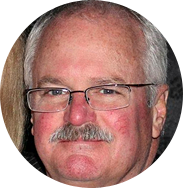
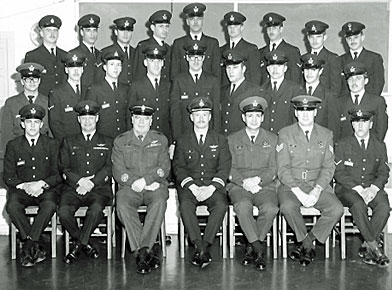
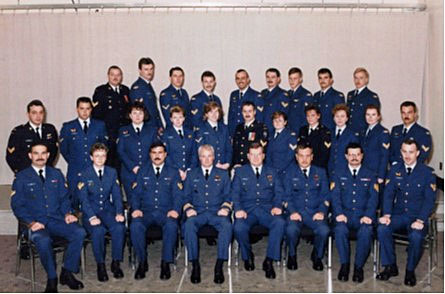
1971 - Initial Movements Course as a Traffic Technician - CFB Borden, ON.
Private Ken Usher
Private Ken Usher
1989 - Commandant of Canadian Forces School of Traffic and Movements CFB Edmonton, AB.
Major Ken Usher
Major Ken Usher
Cheers,
Ken
Ken

From: Stephen Davey, Tadcaster, North Yorks
Subject: The Air Movements School
Tony,
My memories of the Air Movements School (in the photo I'm 3rd from the left, centre row)
Our training flight was taking a load on a Belfast from Brize Norton to RAF Luqa in Malta and then onto Akrotiri, Cyprus. When we arrived at Luqa, our team had the job of offloading and loading for the flight to Akrotiri. What a coincidence at Luqa, 23 Squadron, English Electric Lightnings, were on detachment there, RAF Leuchars being their home base and my parent unit. We returned directly from Akrotiri to Brize; I personally learned more about loading aircraft on that trip than the 8 weeks I was on the course at Abingdon!
Subject: The Air Movements School
Tony,
My memories of the Air Movements School (in the photo I'm 3rd from the left, centre row)
Our training flight was taking a load on a Belfast from Brize Norton to RAF Luqa in Malta and then onto Akrotiri, Cyprus. When we arrived at Luqa, our team had the job of offloading and loading for the flight to Akrotiri. What a coincidence at Luqa, 23 Squadron, English Electric Lightnings, were on detachment there, RAF Leuchars being their home base and my parent unit. We returned directly from Akrotiri to Brize; I personally learned more about loading aircraft on that trip than the 8 weeks I was on the course at Abingdon!

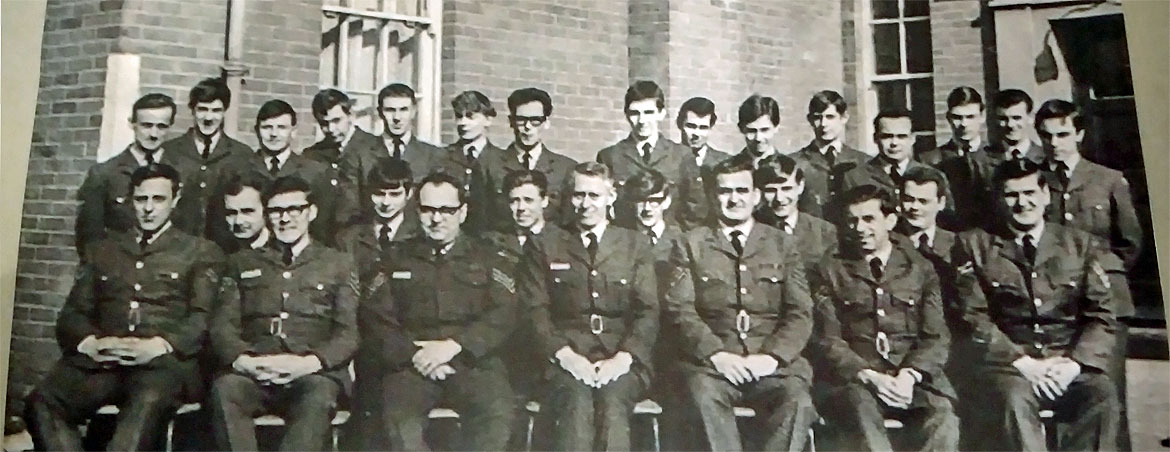
107 Junior Air Movements Course, Air Movements Training School 6th April - 29th May 1970
Rear - SAC's Skeat, Wilson, Jamieson, Buckland, LAC Hawson, SAC's Stephenson, Crutchfield, LAC Gaffney, SAC's Smith, Bowl, Twomey, Holden, Gritt, Shannon, Johnston.
Centre - SAC Kavanagh, LAC Walker, SAC's Davey, Cooke, Woodward, Whalen.
Front - Cpl Ball, Sgt's Illsley, Lewis, Flt Lt Kitchener, FS Beverley, Sgt Dunne, Cpl Forbes.
Centre - SAC Kavanagh, LAC Walker, SAC's Davey, Cooke, Woodward, Whalen.
Front - Cpl Ball, Sgt's Illsley, Lewis, Flt Lt Kitchener, FS Beverley, Sgt Dunne, Cpl Forbes.

Current RAF Pay Scales
(GBP £1 = CAD $1.76 / AUD $1.93 / NZD $2.15)
(GBP £1 = CAD $1.76 / AUD $1.93 / NZD $2.15)
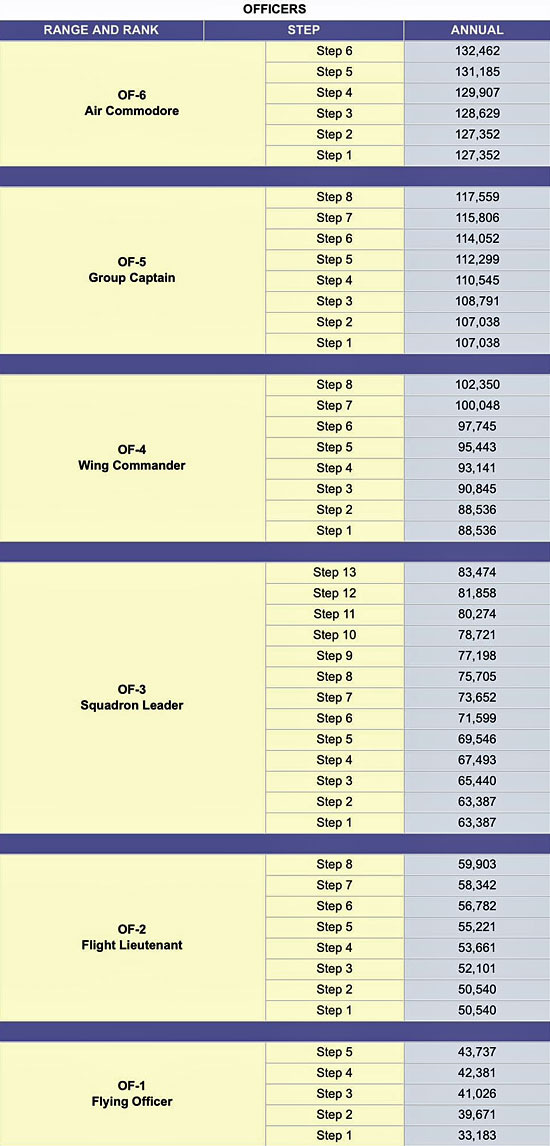
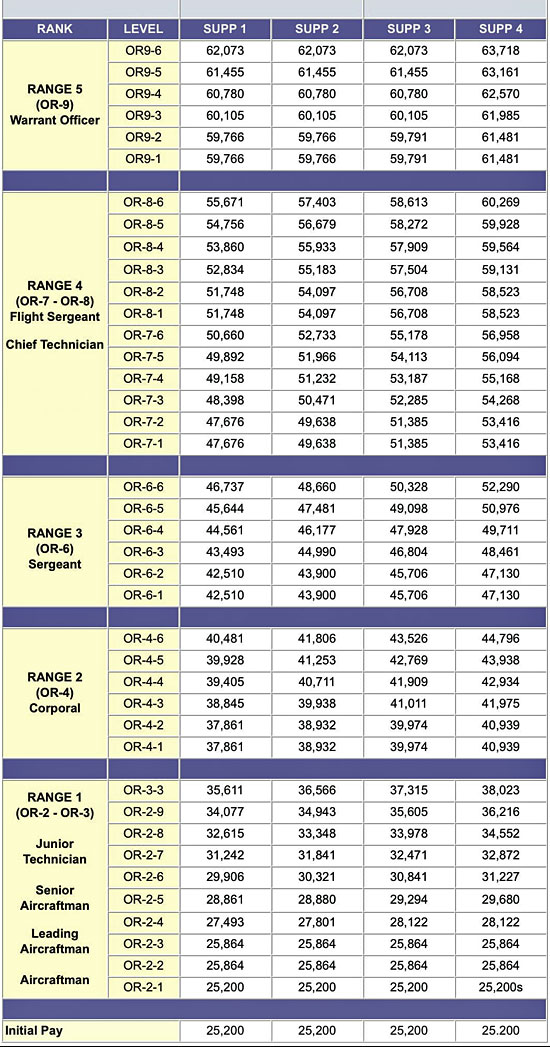

From: Barry Tappenden, Shortstown, Beds
Subject: Remembrance Sunday - and - The Air Movements School
Good evening Tony,
Remembrance Day 2024 - Held on the Bedford Embankment at the Monument. Sponsored by the Bedford Borough Council and Royal British Legion Bedford branch. Very well attended. Photos attached. With me is my youngest grandson Jamie.
Subject: Remembrance Sunday - and - The Air Movements School
Good evening Tony,
Remembrance Day 2024 - Held on the Bedford Embankment at the Monument. Sponsored by the Bedford Borough Council and Royal British Legion Bedford branch. Very well attended. Photos attached. With me is my youngest grandson Jamie.

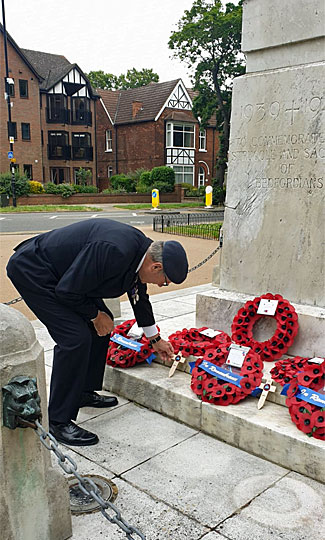
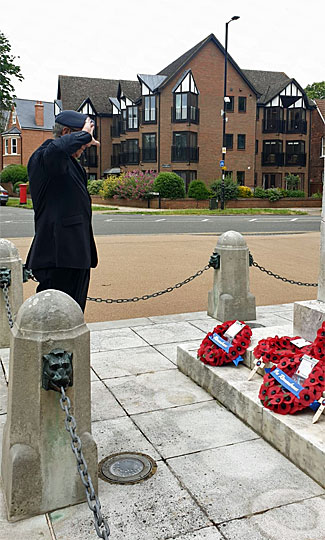
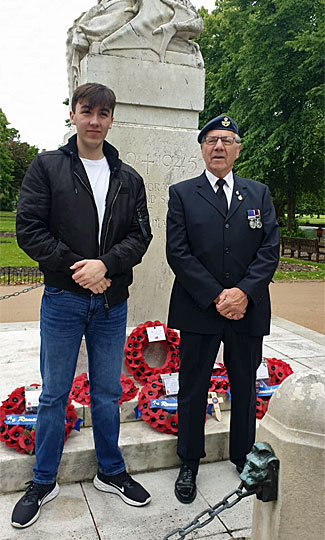
Air Movements School - I attended one of the first ones; unfortunately, I can't find the Group photo but will hunt through all the old computers and laptops. Enjoyed every minute (got me away from SCAF) I remember that they had a mock-up aircraft for the parachutists and we were seen to be "pretending" to be Paras until ("quite roughly") we were told to get back to the course!
Best regards, Barry
Best regards, Barry

From: Chris Goss, Marlow, Bucks
Subject: Attic Find
Subject: Attic Find
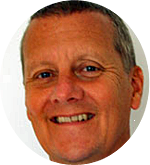
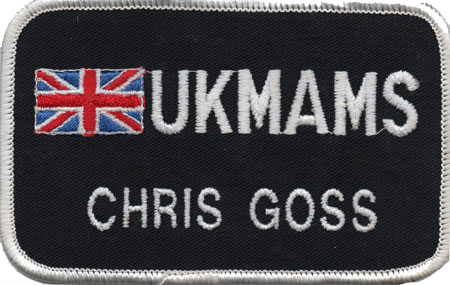
Tony,
I found three of these patches in the attic recently. I left UKMAMS in 1987 so they have been hidden away for 37 years and still bring back great memories.
Best regards, Chris
I found three of these patches in the attic recently. I left UKMAMS in 1987 so they have been hidden away for 37 years and still bring back great memories.
Best regards, Chris

From: Clive Price, Brecon
Subject: Movements School
Hi Tony,
I enjoyed the movements school with its practical work and final ending; I passed with high marks. It made a nice change from four years of shuffling paperwork in a stores office.
One of my memories is the class sergeant telling us that, as the army para school marched everywhere, so should we, but we would not stamp and shout, just move with the quiet dignity more suited to the RAF!
Cheers,
Taff Price
F team (1966/70)
Subject: Movements School
Hi Tony,
I enjoyed the movements school with its practical work and final ending; I passed with high marks. It made a nice change from four years of shuffling paperwork in a stores office.
One of my memories is the class sergeant telling us that, as the army para school marched everywhere, so should we, but we would not stamp and shout, just move with the quiet dignity more suited to the RAF!
Cheers,
Taff Price
F team (1966/70)


UK to scrap aging CH-47s and Pumas
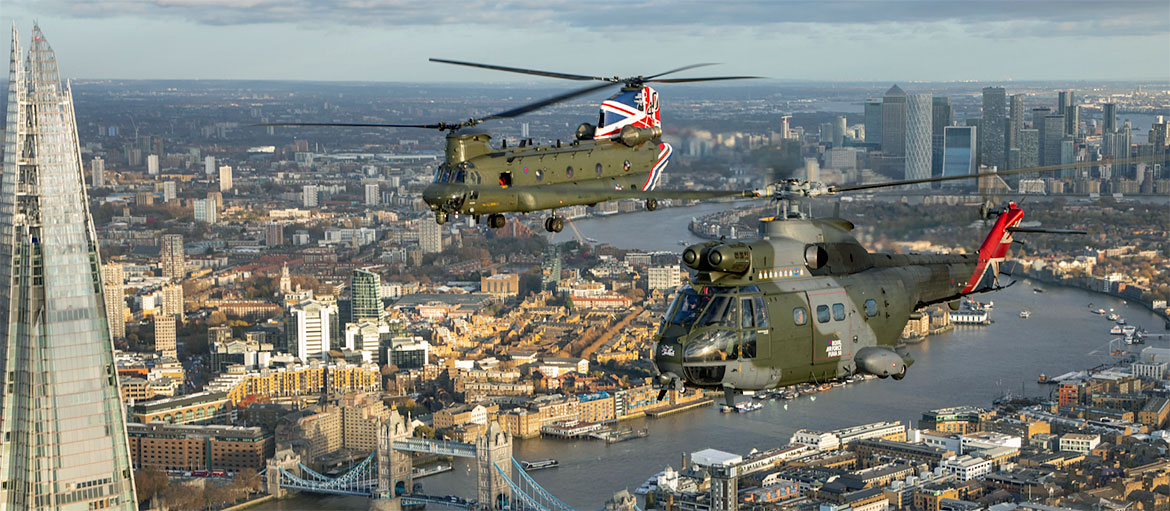
The UK is to scrap aging CH-47 Chinooks and Pumas as part of an effort to save the Ministry of Defence up to £500 million over the next five years.
The cuts, announced by Defence Secretary John Healy in an update on defence capabilities on Nov. 20, will see 14 Chinooks accelerated out of service, while 17 Pumas will be withdrawn from service in March 2025. Healy, part of the new labour government that was elected in July, said technology is rapidly changing the nature of warfare, as illustrated by the war in Ukraine.
In May 2022, the UK launched the New Medium Helicopter (NMH) program, with the primary objective of finding a type to replace the Puma in the UK’s medium-lift fleet.
verticalmag.com
The cuts, announced by Defence Secretary John Healy in an update on defence capabilities on Nov. 20, will see 14 Chinooks accelerated out of service, while 17 Pumas will be withdrawn from service in March 2025. Healy, part of the new labour government that was elected in July, said technology is rapidly changing the nature of warfare, as illustrated by the war in Ukraine.
In May 2022, the UK launched the New Medium Helicopter (NMH) program, with the primary objective of finding a type to replace the Puma in the UK’s medium-lift fleet.
verticalmag.com

From: Mike Lefebvre, Burton, NB
Subject: The Air Movements School
Hello Tony,
I joined in 1965, spent a while in St Jean Quebec on basic courses before being selected to become a Trans Tech. I arrived in Borden Ontario one week after the course started so I had to wait for the next one to start. To keep me busy, I was employed at the central warehouse in various jobs and doing cleaning in the building used to celebrate course graduations until my course started.
Once it started, we were driving forklifts and mules, loading the aircraft fuselage in the hangar, driving stake trucks on backroads convoys and then in between all of this, there were typing classes and tie-down demonstrations on a resemblance of an aircraft floor. All of this with rope(s) and getting us ready to tie down loads on Boxcar aircraft.
Upon graduation I was posted to Trenton, Ontario, and never saw a Boxcar; we now had Hercules that had replaced them.
So, all in all, I was with a roommate fellow trans tech on course for two courses and already knew some that were posted all across the country and overseas upon graduation.
I still think that I spent 27 years of Transportation/Traffic Technician enjoying the friendship and hard work right to the end.
Greetings all.
Subject: The Air Movements School
Hello Tony,
I joined in 1965, spent a while in St Jean Quebec on basic courses before being selected to become a Trans Tech. I arrived in Borden Ontario one week after the course started so I had to wait for the next one to start. To keep me busy, I was employed at the central warehouse in various jobs and doing cleaning in the building used to celebrate course graduations until my course started.
Once it started, we were driving forklifts and mules, loading the aircraft fuselage in the hangar, driving stake trucks on backroads convoys and then in between all of this, there were typing classes and tie-down demonstrations on a resemblance of an aircraft floor. All of this with rope(s) and getting us ready to tie down loads on Boxcar aircraft.
Upon graduation I was posted to Trenton, Ontario, and never saw a Boxcar; we now had Hercules that had replaced them.
So, all in all, I was with a roommate fellow trans tech on course for two courses and already knew some that were posted all across the country and overseas upon graduation.
I still think that I spent 27 years of Transportation/Traffic Technician enjoying the friendship and hard work right to the end.
Greetings all.


From: Ian Russell, Algarve
Subject: The Air Movements School
Dear Tony,
Amazing what a couple of glasses of lovely Portuguese red can do. I read your latest subject for the next OBA newsletter regarding the RAF Movements School and could not resist a contribution. I have several recollections: as a student, commanding the School, and then (shame on me?) as a member of the Defence Training Review team which recommended the formation of the Defence Movements School.
Student - On my Officers' Movements Course, I was happy to discover that our course, as well as several future ones, was co-scheduled to run at RAF Brize Norton alongside an Aeromed Course, which at that time was specifically for Nursing Sisters. We were all accommodated in RAF Brize Norton's Officers' Mess. I recall being rebuked after our course ‘meet and greet’ by one of our officer instructors for spending too much time with the Aeromed ‘girls‘ rather than properly bonding with my new course mates. Our instructors were superb, but the poor guys had to contend with the fact that all lessons at the time were based upon overhead projection slides. They would arrive with a pile of those and be met with a collective groan. Despite being told that my first choice of posting (a UK MAMS Team Leader*) was unlikely, I was overjoyed to find that, on return from our Akrotiri final training phase, I was posted to Lyneham as a Pilot Officer Team Leader.
Officer Commanding - On posting from OC Air Portability at JATE to command the RAFMS, I was so lucky to have a wonderful team of Officer and SNCO Movements staff members and a similarly impressive admin team. I was particularly fortunate to be supported by WO Colin Allen as School WO. He was such a level headed and supremely professional individual, with a great sense of humour. I attach a photo of some historical RAF baggage tags that he presented to me during our time together. I still have them in safe keeping.
Subject: The Air Movements School
Dear Tony,
Amazing what a couple of glasses of lovely Portuguese red can do. I read your latest subject for the next OBA newsletter regarding the RAF Movements School and could not resist a contribution. I have several recollections: as a student, commanding the School, and then (shame on me?) as a member of the Defence Training Review team which recommended the formation of the Defence Movements School.
Student - On my Officers' Movements Course, I was happy to discover that our course, as well as several future ones, was co-scheduled to run at RAF Brize Norton alongside an Aeromed Course, which at that time was specifically for Nursing Sisters. We were all accommodated in RAF Brize Norton's Officers' Mess. I recall being rebuked after our course ‘meet and greet’ by one of our officer instructors for spending too much time with the Aeromed ‘girls‘ rather than properly bonding with my new course mates. Our instructors were superb, but the poor guys had to contend with the fact that all lessons at the time were based upon overhead projection slides. They would arrive with a pile of those and be met with a collective groan. Despite being told that my first choice of posting (a UK MAMS Team Leader*) was unlikely, I was overjoyed to find that, on return from our Akrotiri final training phase, I was posted to Lyneham as a Pilot Officer Team Leader.
Officer Commanding - On posting from OC Air Portability at JATE to command the RAFMS, I was so lucky to have a wonderful team of Officer and SNCO Movements staff members and a similarly impressive admin team. I was particularly fortunate to be supported by WO Colin Allen as School WO. He was such a level headed and supremely professional individual, with a great sense of humour. I attach a photo of some historical RAF baggage tags that he presented to me during our time together. I still have them in safe keeping.

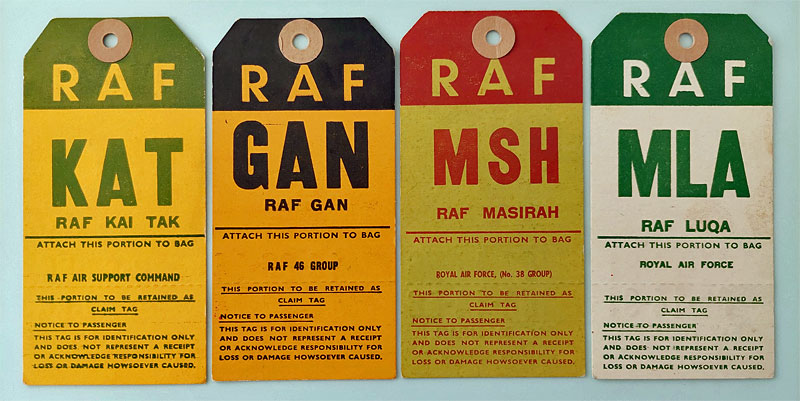
My other abiding memory is the ‘Hangar Exercises’, where I and the other staff had fun as well as trying to instil some training and appropriately realistic assessments. However, I overstepped the mark when I assessed one of the officers whose lead it was, of a ‘shambolic performance’. He did not deserve that and one of my instructor SNCOs (who was not backward at coming forward) said to me ‘Boss, were you really that good as a Pilot Officer when you attended your Officers Movements Course?’ A lesson in humility to be sure. I attach a wonderful cartoon from that excellent artist and all round good guy Gordon Bock, one of my staff at the time. He superbly encapsulates every aspect of the School during that era. Again, I still have the original cartoon in safe keeping.
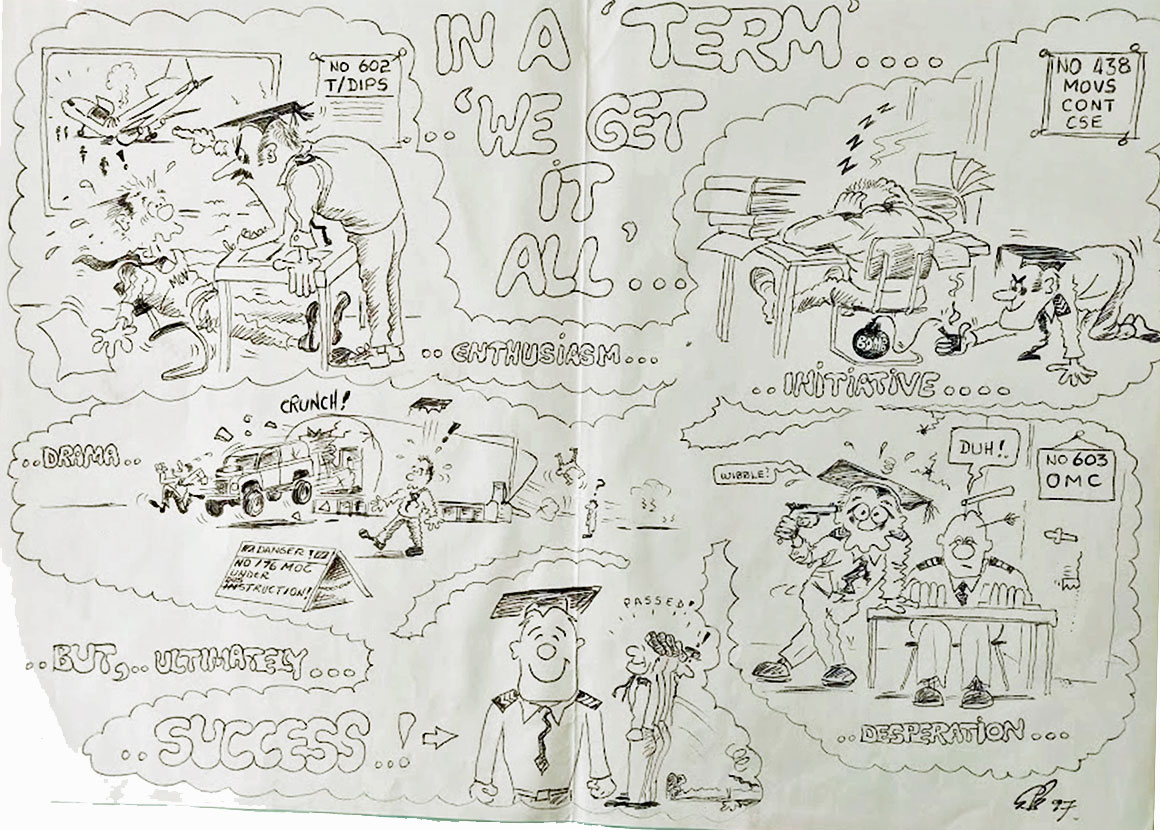
Defence Training Review - I was fortunate to experience several Movements tours after the School, primarily in NATO operational and non-operational roles. Then onto the Defence Training Review team. It was fascinating to visit so many individual service training establishments and learn of their methods of instruction and ethos of training. Throughout my Movements experience, the vast majority was spent in direct contact with other nations and the other UK services, especially the RCT/RLC, so hopefully the ‘Defence’ approach to Movements training will have proved its worth.
*‘Swift to Move, Hard to Swallow’
*‘Swift to Move, Hard to Swallow’

RNZAF's new Hercules plane lands in Antarctica for first time
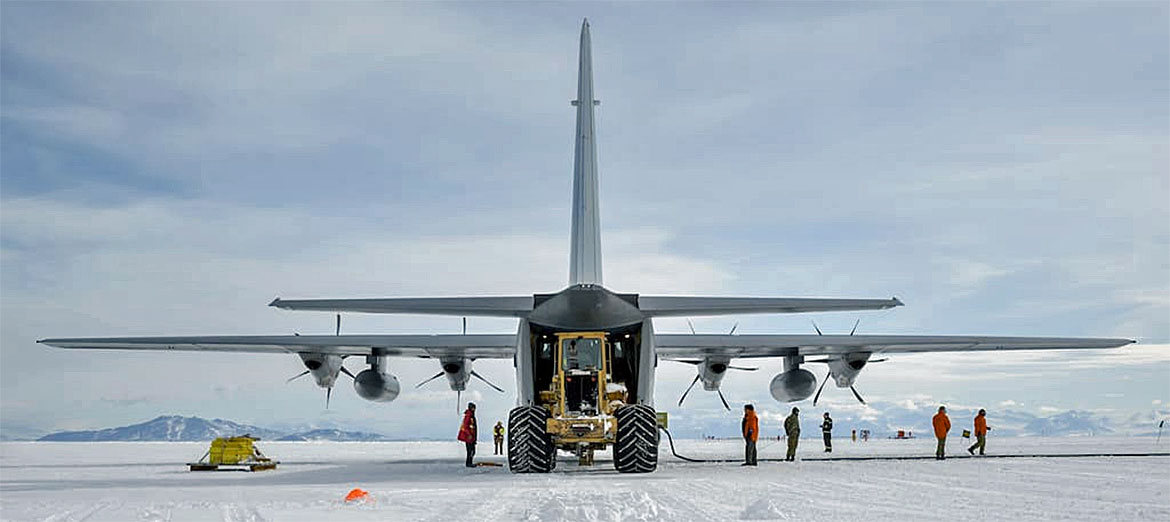
The newest addition to the Royal New Zealand Air Force's Hercules fleet has touched down in Antarctica on its maiden journey, the first of six it will make this summer. Yesterday's flight carried cargo to the ice that would support the New Zealand and United States scientific research programmes at Scott Base and McMurdo Station.
Having already piloted 11 flight to Antarctica, Lieutenant Tristan Nysse said it was a rewarding experience becoming the first to fly the C-130J. "We are just a small team at the C-130J Transition Unit, so having completed our first flight to the ice is not only a success for the aircrew — [but] also the maintenance crews and everyone involved in the C-130J delivery who have put in a massive effort to make this possible." He said the new model flew "similarly" to the old Hercules but with "all the bells and whistles". "It's nice having the extra power of the new engines and more advanced electronic planning systems which makes preparing for our tasks much faster and simpler," he said.
The C-130J is scheduled to make six trips this summer season carrying a mix of passengers and cargo, as part of NZDF's enduring Operation Antartica which had contributed personnel to the icy continent since the 1950s.
Senior National Officer Major Lucy Wright said the first flight with the C-130J was a significant milestone in the introduction of new capability in support of the Joint Logistics Pool. "The C-130H has been a reliable workhorse for the Antarctic programmes for close to 60 years and everyone is very excited to have the new C-130J continue to provide that support."
1news.co.nz
Having already piloted 11 flight to Antarctica, Lieutenant Tristan Nysse said it was a rewarding experience becoming the first to fly the C-130J. "We are just a small team at the C-130J Transition Unit, so having completed our first flight to the ice is not only a success for the aircrew — [but] also the maintenance crews and everyone involved in the C-130J delivery who have put in a massive effort to make this possible." He said the new model flew "similarly" to the old Hercules but with "all the bells and whistles". "It's nice having the extra power of the new engines and more advanced electronic planning systems which makes preparing for our tasks much faster and simpler," he said.
The C-130J is scheduled to make six trips this summer season carrying a mix of passengers and cargo, as part of NZDF's enduring Operation Antartica which had contributed personnel to the icy continent since the 1950s.
Senior National Officer Major Lucy Wright said the first flight with the C-130J was a significant milestone in the introduction of new capability in support of the Joint Logistics Pool. "The C-130H has been a reliable workhorse for the Antarctic programmes for close to 60 years and everyone is very excited to have the new C-130J continue to provide that support."
1news.co.nz

From: David Powell, Princes Risborough, Bucks
Subject: The Air Movements School
Dear Tony,
Subject: The Air Movements School
Dear Tony,

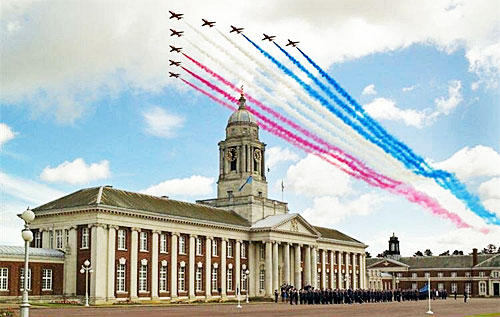
Despite your comment about hoping that we all went through the Air Movements School, not quite true. This did not apply to those who undertook their movements qualification training at the RAF College, Cranwell, like yours truly.
Cranwell was where those earmarked, often rather optimistically, as having potential for greater glories, went to be trained. Indeed, in terms of reaching for the stars, one of our entry actually did: Air Chief Marshal Sir John Allison.
While another in our entry also created history, as being the first RAF College Flight Cadet to swap his opportunity of wings and a passing-out parade for 6 months in Brixton Prison. In those days there was nothing unusual seeing flight cadets hammering and filing bits on their battered cars in the College’s motor club workshop. However, in this case the filing had included engine block serial numbers on stolen cars!
Cranwell was where those earmarked, often rather optimistically, as having potential for greater glories, went to be trained. Indeed, in terms of reaching for the stars, one of our entry actually did: Air Chief Marshal Sir John Allison.
While another in our entry also created history, as being the first RAF College Flight Cadet to swap his opportunity of wings and a passing-out parade for 6 months in Brixton Prison. In those days there was nothing unusual seeing flight cadets hammering and filing bits on their battered cars in the College’s motor club workshop. However, in this case the filing had included engine block serial numbers on stolen cars!
Back then, in the 1960s, the process of learning how to be officers or gentlemen, and occasionally both, as General List pilots, navigators, secretarial or equipment (later to become supply and then logistics) specialists, took 3 years. Much of the time was spent on the core programme, military history, PT, academics etc. Then, when the baby aircrew were learning how to fly or get lost, 5 of our entry including me, would go off to an obscure collection of wooden huts to master the mysteries of Form 674 Issue Vouchers as well as, in our final year, explosives and movements. Note, not air movements. We also covered stores movement by sea, rail and road.
For the famous 5, it was obvious from the outset that as movements officers, we would be immersed in procedures and paperwork in order to look intelligent when talking to the inhabitants of the RAF movement’s coal face. Getting our hands dirty was not really in our expected job descriptions. As a result, we spent many hours studying airway-bills and trim sheets, including the Beverley’s which had a vertical component as well as the universal horizontal balancing trick. However, when it came to practicalities, we may have had a Hastings floor chalked out in one of the hangers and a collection of (mainly scrounged and usually broken) chains, strops and strainers, when it came to aircraft mock-ups and pallets and vehicles, even one with bullet holes, not a lot. Instead, during the final term we were dispatched for a brilliant week’s reality check at RAF Lyneham.
Finally, I was however at RAF Abingdon as a living-in junior UKMAMS officer, when it was then the happy home of the Air Movements School. The succession of classes of young RAF and especially WRAF student movements officers certainly helped make this a very happy and lively mess. As you probably know, it was also when and where the collective term of ‘Jam Stealers’ for movers came about. With the School’s lectures finishing at around 4, or that’s what it seemed, by the time the rest us residents trooped back into the Mess for a cup of tea and a slice of toast, all the jam had disappeared!
Happy memories, stay safe
David Powell
F Team UKMAMS 1967-69
For the famous 5, it was obvious from the outset that as movements officers, we would be immersed in procedures and paperwork in order to look intelligent when talking to the inhabitants of the RAF movement’s coal face. Getting our hands dirty was not really in our expected job descriptions. As a result, we spent many hours studying airway-bills and trim sheets, including the Beverley’s which had a vertical component as well as the universal horizontal balancing trick. However, when it came to practicalities, we may have had a Hastings floor chalked out in one of the hangers and a collection of (mainly scrounged and usually broken) chains, strops and strainers, when it came to aircraft mock-ups and pallets and vehicles, even one with bullet holes, not a lot. Instead, during the final term we were dispatched for a brilliant week’s reality check at RAF Lyneham.
Finally, I was however at RAF Abingdon as a living-in junior UKMAMS officer, when it was then the happy home of the Air Movements School. The succession of classes of young RAF and especially WRAF student movements officers certainly helped make this a very happy and lively mess. As you probably know, it was also when and where the collective term of ‘Jam Stealers’ for movers came about. With the School’s lectures finishing at around 4, or that’s what it seemed, by the time the rest us residents trooped back into the Mess for a cup of tea and a slice of toast, all the jam had disappeared!
Happy memories, stay safe
David Powell
F Team UKMAMS 1967-69

From: Neville Whitham, Cuerden, Bamber Bridge, Lancs
Subject: Remembrance Sunday
Hi Tony,
Re. your topics for this month's publication of the OBA newsletter, for me it was "Acts of Remembrance" rather than just Remembrance Sunday. On the 6 June 24, there was the 80th anniversary of "D-Day Remembrance", for which I laid a wreath on behalf of Chorley Council. Next up was the Manchester Airport Festival of Remembrance, on 7th Nov, held under the wings of Concorde (G-BOAC), which is always an excellent, well put together event.
On Remembrance Sunday, I always take part in the procession from Chorley Town Hall to Astley Park, the whole of which was bequeathed by Reginald Tatton to the people of Chorley in 1924, primarily to provide a War Memorial Cenotaph for the fallen of WW1. After this, I attend a short service to the "Chorley PALS" at a dedicated memorial and then in the afternoon, go on to lay a wreath at the Clayton & Whittle War Memorial on behalf of Sir Lindsay Hoyle MP, Speaker of the House of Commons.
On the Monday, 11 Nov, as I am on the War Memorial Committee, we hosted the Armistice Day Service at Clayton & Whittle so that some pupils and teachers from eight local schools could attend. They all laid wreaths, which the pupils had made themselves and were recyclable. Handing on the baton to the younger generation is what its all about - Lest We Forget.
Subject: Remembrance Sunday
Hi Tony,
Re. your topics for this month's publication of the OBA newsletter, for me it was "Acts of Remembrance" rather than just Remembrance Sunday. On the 6 June 24, there was the 80th anniversary of "D-Day Remembrance", for which I laid a wreath on behalf of Chorley Council. Next up was the Manchester Airport Festival of Remembrance, on 7th Nov, held under the wings of Concorde (G-BOAC), which is always an excellent, well put together event.
On Remembrance Sunday, I always take part in the procession from Chorley Town Hall to Astley Park, the whole of which was bequeathed by Reginald Tatton to the people of Chorley in 1924, primarily to provide a War Memorial Cenotaph for the fallen of WW1. After this, I attend a short service to the "Chorley PALS" at a dedicated memorial and then in the afternoon, go on to lay a wreath at the Clayton & Whittle War Memorial on behalf of Sir Lindsay Hoyle MP, Speaker of the House of Commons.
On the Monday, 11 Nov, as I am on the War Memorial Committee, we hosted the Armistice Day Service at Clayton & Whittle so that some pupils and teachers from eight local schools could attend. They all laid wreaths, which the pupils had made themselves and were recyclable. Handing on the baton to the younger generation is what its all about - Lest We Forget.

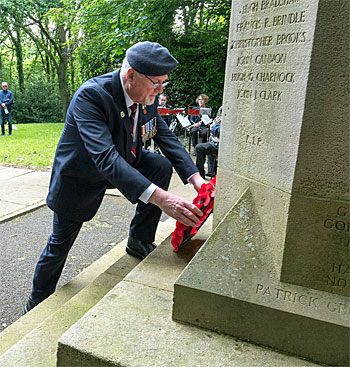
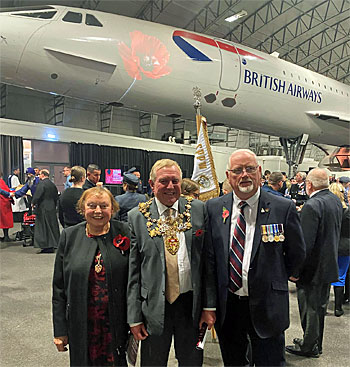
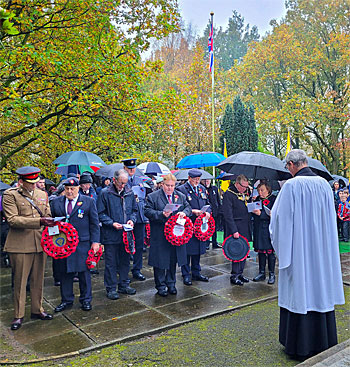
D-Day 80th - 6.6.24
Clayton & Whittle War Memorial
Clayton & Whittle War Memorial
Festival of Remembrance, with Mayor & Mayoress of Chorley, Cllrs Gordon & Margaret France at Manchester Airport
Clayton & Whittle War Memorial
on a wet afternoon 10.11.24
on a wet afternoon 10.11.24
Yet again, many thanks for your great endeavours in putting together the OBA Newsletter Tony.
Kind regards, Nev
Kind regards, Nev

From: Ian Berry, Eastleaze, Swindon, Wilts
Subject: Remembrance Sunday - and - The Air Movements School
Hi Tony,
Two pictures from Remembrance Day but neither was this year. One is with my daughter and the other includes David Powell and in the centre is Merv Johns. Merv I have known for over 50 years when he was on Mobile Servicing at Brize whilst we were at Abingdon and as you must remember we worked hand in glove. Merv was a JT then and affectionately known as "Bogs & Water" as he got an extra 50p a day to empty the Elsans!
Subject: Remembrance Sunday - and - The Air Movements School
Hi Tony,
Two pictures from Remembrance Day but neither was this year. One is with my daughter and the other includes David Powell and in the centre is Merv Johns. Merv I have known for over 50 years when he was on Mobile Servicing at Brize whilst we were at Abingdon and as you must remember we worked hand in glove. Merv was a JT then and affectionately known as "Bogs & Water" as he got an extra 50p a day to empty the Elsans!
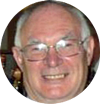
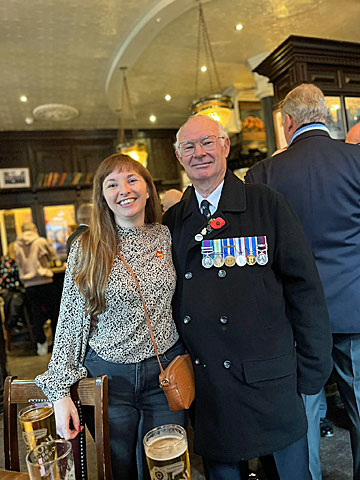
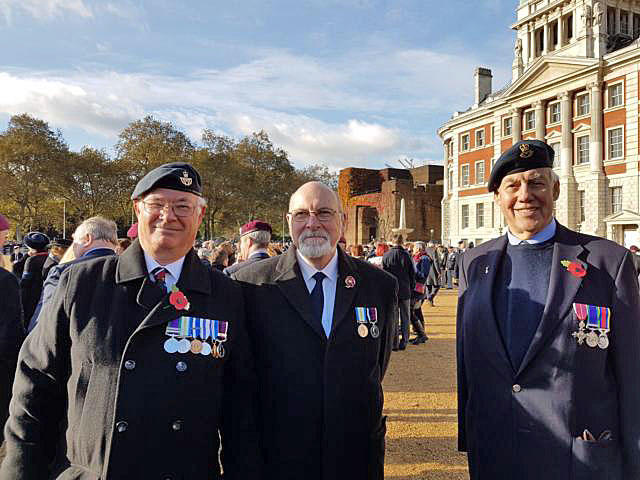
MEMORIES OF RAF ABINGDON
My first visit to RAF Abingdon was, like most, to attend a Junior Air Movements Course, No 37 to be precise in August - October 1967. My good friend and later best man, Bob Tring, was there on the course ahead of me, along with Keith Simmonds who was on my course. They were both at Thorney Island at the time I believe; I had travelled from the other end of the country, 6 FTS RAF Acklington.
From day one I was so keen to be on the course and the topics concerning all matters “Movements” kept my attention. The opportunity to be near and even have “hands on” experience of live aircraft was also a bonus. Our accommodation though, to say the least, was not the best! The Airmens' Mess also seemed proficient at converting edible ingredients into a barely edible dish. To cap it all off, the entire NAAFI was full of testosterone charged baby Paras!
My first visit to RAF Abingdon was, like most, to attend a Junior Air Movements Course, No 37 to be precise in August - October 1967. My good friend and later best man, Bob Tring, was there on the course ahead of me, along with Keith Simmonds who was on my course. They were both at Thorney Island at the time I believe; I had travelled from the other end of the country, 6 FTS RAF Acklington.
From day one I was so keen to be on the course and the topics concerning all matters “Movements” kept my attention. The opportunity to be near and even have “hands on” experience of live aircraft was also a bonus. Our accommodation though, to say the least, was not the best! The Airmens' Mess also seemed proficient at converting edible ingredients into a barely edible dish. To cap it all off, the entire NAAFI was full of testosterone charged baby Paras!
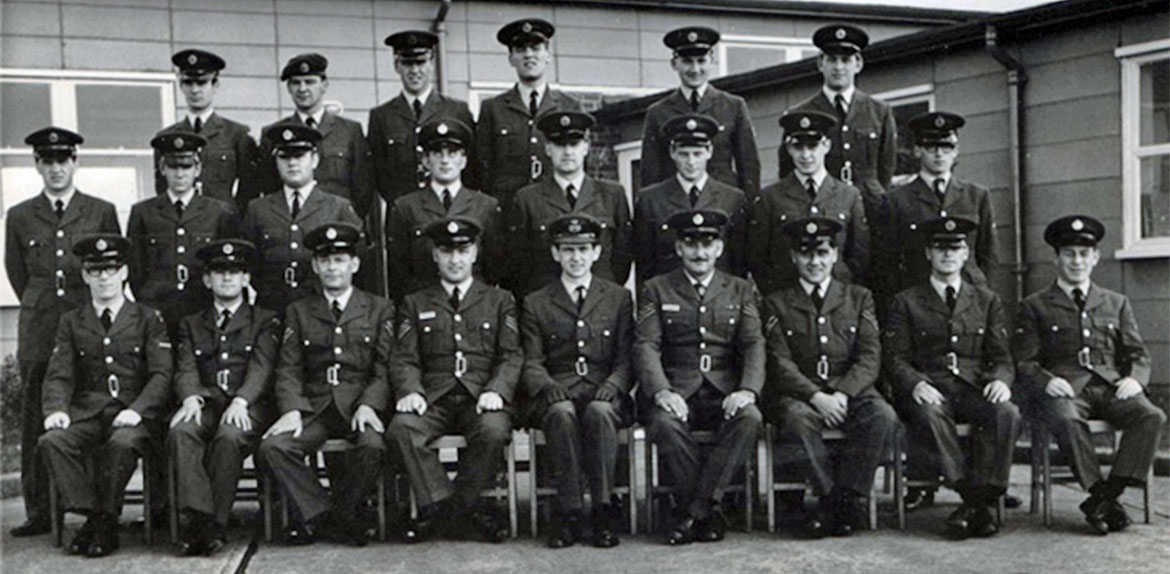
37 JAMC AMTS ABINGDON – AUG TO OCT 1967
Rear - SAC Berry, LAC Lodge, SAC Moore, LAC's Hill, Senior, O'Sullivan
Centre - SAC's Action, Treadwell, LAC's Blackman, Tucker, Lee, Paxton, Winterburn, Zammit
Front - LAC Twig, SAC Simmonds, Cpl Taylor, Sgt Pike, Fg Off Hyland, Sgt Gutteridge, Cpl Thomas, LAC's Bartlett, McLaughlin
Centre - SAC's Action, Treadwell, LAC's Blackman, Tucker, Lee, Paxton, Winterburn, Zammit
Front - LAC Twig, SAC Simmonds, Cpl Taylor, Sgt Pike, Fg Off Hyland, Sgt Gutteridge, Cpl Thomas, LAC's Bartlett, McLaughlin
Consequently the arrival of the NAAFI van at breaks was a Godsend with fantastic crusty ham rolls... Also at this time the aircraft based and operated there were 46 Sqn Andover’s and 47 Sqn Beverley’s... As with most, our live practical phase involved taking over and loading a Beverley from the Air Movements Squadron and then flying with it to RAF Wildenrath. Quite an experience and another type in my log book!
Back from this and we took our finals, quite involved as there were trim exams, fault finding, theory etc... I did really well though and was surprised to receive a Certificate of Merit. My last day at Abingdon though was marred by my misdeeds when at the end of the “Farewell P*** Up” downtown I collected a paraffin fuelled road lamp from some road works on the way back to camp. The next day the barrack room was covered in soot!
Back from this and we took our finals, quite involved as there were trim exams, fault finding, theory etc... I did really well though and was surprised to receive a Certificate of Merit. My last day at Abingdon though was marred by my misdeeds when at the end of the “Farewell P*** Up” downtown I collected a paraffin fuelled road lamp from some road works on the way back to camp. The next day the barrack room was covered in soot!
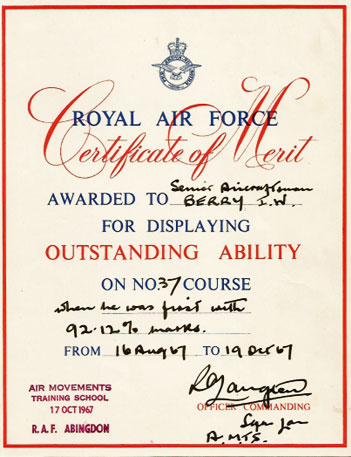
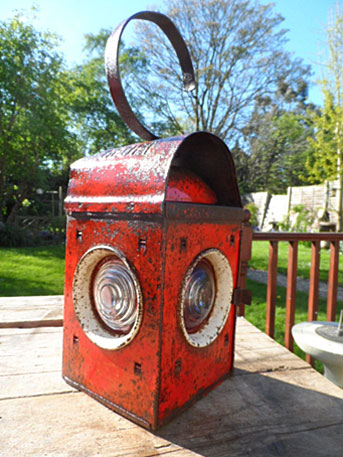
Best regards, Ian
The Surprising Military Service of the British Royal Family
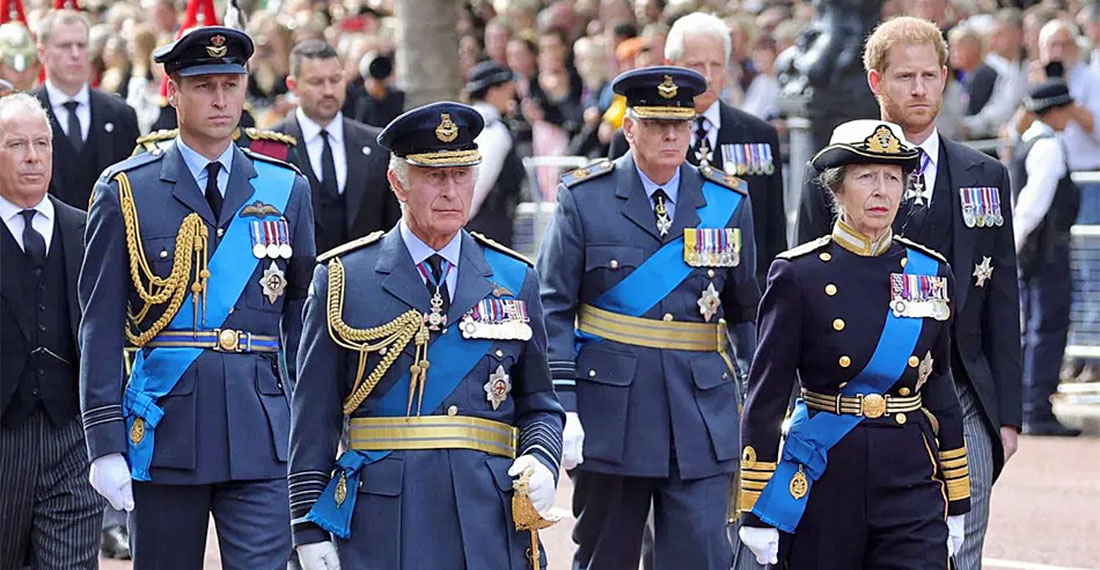
King Charles III
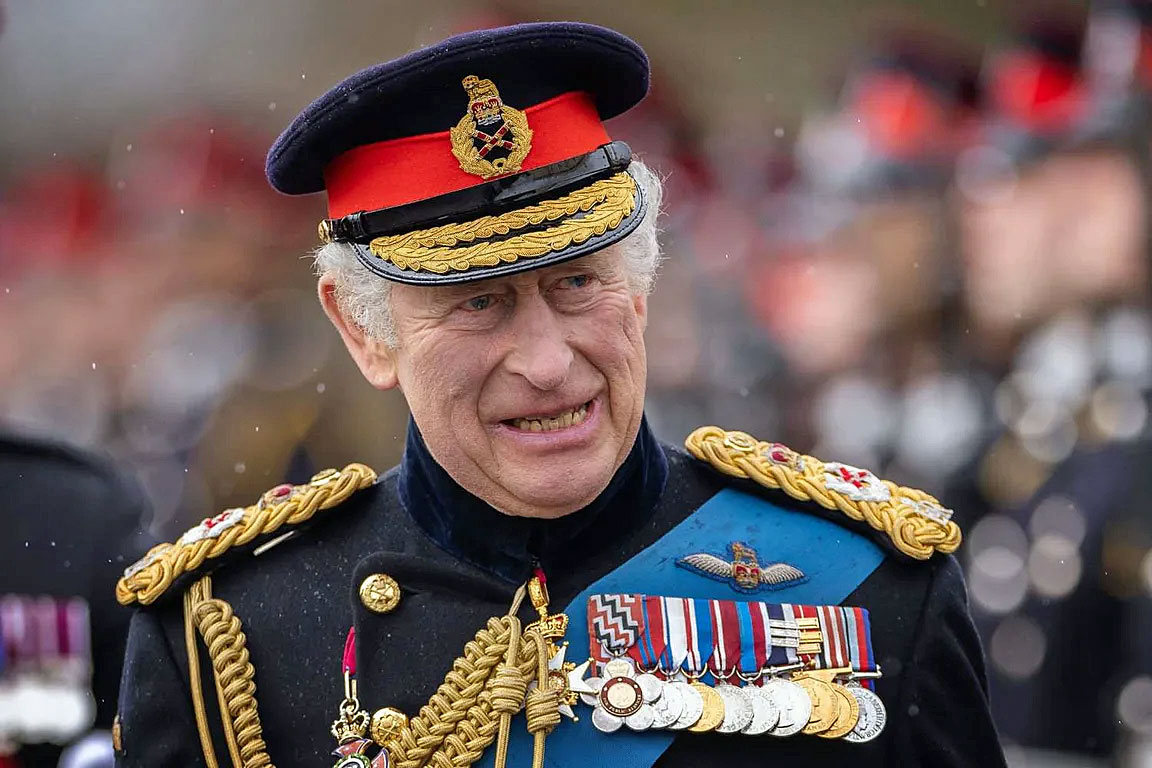
As Sovereign, the King is the head of the Armed Forces and is also known as the Commander-in-Chief. He is the only person to declare war and peace.
The King served in the Royal Navy, as did his father, grandfather and his great-grandfathers. He also served in the Royal Air Force during the 1970s.
Despite having left the military, the King holds his Commander-in-Chief title since the passing of his mother, Queen Elizabeth II, and also became Captain General of the Royal Marines.
The King has 11 medals on his uniform including: the Queen’s Service Medal, the Coronation Medal, the Silver Jubilee Medal, the Golden Jubilee Medal, the Diamond Jubilee Medal, the Platinum Jubilee Medal, the Naval Long Service Good Conduct Medal, the Canadian Forces Decoration, the New Zealand Commemorative Medal, the New Zealand Armed Forces Award and the Garter Star.
The King served in the Royal Navy, as did his father, grandfather and his great-grandfathers. He also served in the Royal Air Force during the 1970s.
Despite having left the military, the King holds his Commander-in-Chief title since the passing of his mother, Queen Elizabeth II, and also became Captain General of the Royal Marines.
The King has 11 medals on his uniform including: the Queen’s Service Medal, the Coronation Medal, the Silver Jubilee Medal, the Golden Jubilee Medal, the Diamond Jubilee Medal, the Platinum Jubilee Medal, the Naval Long Service Good Conduct Medal, the Canadian Forces Decoration, the New Zealand Commemorative Medal, the New Zealand Armed Forces Award and the Garter Star.
Prince Andrew, Duke of York
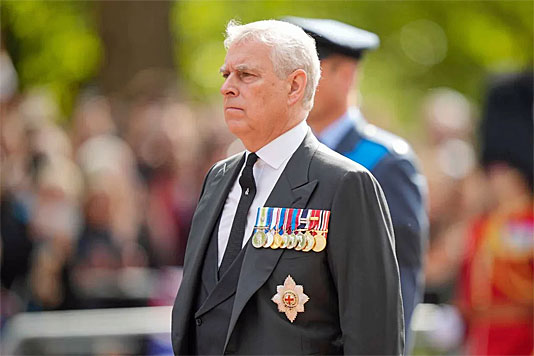
Prince Andrew joined the Royal Navy in 1979 and spent the following two years completing his flight training. He completed this in 1981, receiving his credentials and the best pilot award from his father, Prince Philip.
After 22 years of active service in the Royal Navy, he retired from the Royal Navy in 2001 with the rank of Commander and has since ranked to Honorary Captain, Rear Admiral and now Vice-Admiral in 2015.
In 2022, Andrew’s military titles and royal patronages were returned to the Queen due to his sexual assault allegations.
Prince Andrew has the following medals: South Atlantic Campaign medal, Silver Jubilee medal, the Golden Jubilee medal, the Diamond Jubilee medal, the Platinum Jubilee medal, Naval Long Service, Canadian Forces Decoration, New Zealand Commemorative medal, Order of the Garter and Royal Victorian Order
After 22 years of active service in the Royal Navy, he retired from the Royal Navy in 2001 with the rank of Commander and has since ranked to Honorary Captain, Rear Admiral and now Vice-Admiral in 2015.
In 2022, Andrew’s military titles and royal patronages were returned to the Queen due to his sexual assault allegations.
Prince Andrew has the following medals: South Atlantic Campaign medal, Silver Jubilee medal, the Golden Jubilee medal, the Diamond Jubilee medal, the Platinum Jubilee medal, Naval Long Service, Canadian Forces Decoration, New Zealand Commemorative medal, Order of the Garter and Royal Victorian Order
Prince Edward, Duke of Kent
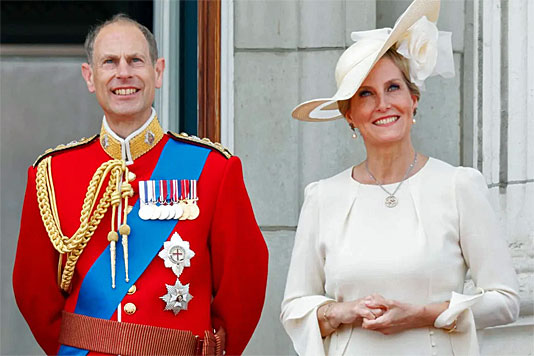
After graduating in 1986, Prince Edward joined the Royal Marines, but dropped out of the commando course the following year to pursue a career in entertainment. Despite having left the Royal Marines early on, he holds eight military appointments and meets service personnel when needed.
In 2006 he was appointed Commodore-in-Chief of the Royal Fleet Auxiliary and in 2007, he became Royal Colonel of 2nd Battalion The Rifles. The following year he was made the Honorary Air Commodore of Royal Air Force Waddington.
The Prince has the following medals: The Garter Star, the Neck Order, the UN Peace Keeping medal, the King George Coronation medal, the Queen’s Coronation medal, the Golden Jubilee medal, the Diamond Jubilee medal, Long Services medal, Canadian Long Service medal, Sierra Leone Independence medal, Guyana Independence medal and the Royal Victorian Order.
In 2006 he was appointed Commodore-in-Chief of the Royal Fleet Auxiliary and in 2007, he became Royal Colonel of 2nd Battalion The Rifles. The following year he was made the Honorary Air Commodore of Royal Air Force Waddington.
The Prince has the following medals: The Garter Star, the Neck Order, the UN Peace Keeping medal, the King George Coronation medal, the Queen’s Coronation medal, the Golden Jubilee medal, the Diamond Jubilee medal, Long Services medal, Canadian Long Service medal, Sierra Leone Independence medal, Guyana Independence medal and the Royal Victorian Order.
Prince William of Wales
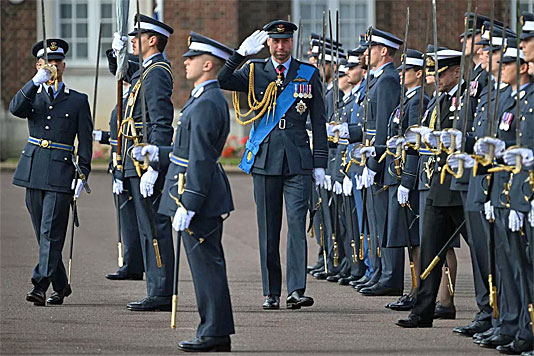
Prince William was admitted to the Royal Military Academy Sandhurst in 2006 which led to his commission as a British Army officer. After becoming a second lieutenant through the completion of training at Bovington Camp in Dorset, he trained in the Royal Navy and Royal Air-Force.
From this training, Will was appointed sub-lieutenant, and was promoted to lieutenant a year later, along with his pilot training in the British military.
He completed seven and a half years of full-time military service, and is now the patron of the Royal Air Force Battle of Britain Memorial Flight and Honorary Air Commandment of Royal Air Force Coningsby.
The Prince has the following medals: The Golden Jubilee medal, the Diamond Jubilee medal, the Platinum Jubilee medal, Order of the Garter and Great Master of the Order of the Bath.
From this training, Will was appointed sub-lieutenant, and was promoted to lieutenant a year later, along with his pilot training in the British military.
He completed seven and a half years of full-time military service, and is now the patron of the Royal Air Force Battle of Britain Memorial Flight and Honorary Air Commandment of Royal Air Force Coningsby.
The Prince has the following medals: The Golden Jubilee medal, the Diamond Jubilee medal, the Platinum Jubilee medal, Order of the Garter and Great Master of the Order of the Bath.
Prince Harry, Duke of Sussex
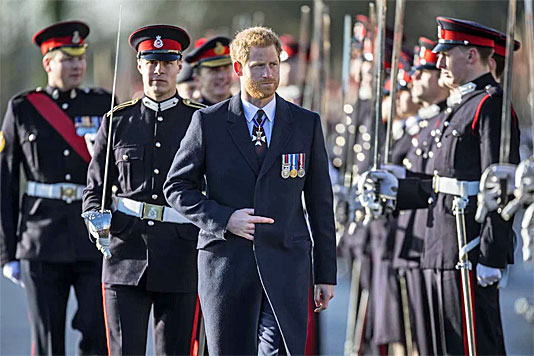
Prince Harry was a member of the armed forces for 10 years, beginning his service in 2005. He began his officer cadet training at the Royal Military Academy Sandhurst and joined the Blues and Royals the following year commissioned as a Army officer. From 2007 to 2008, he was deployed to Afghanistan working as a forward air controller and was promoted in 2008 to the rank of Lieutenant with the Household Cavalry. Four years later, he completed his training as a pilot of Apache helicopters in the Army Air Corps before being deployed again for a year.
In 2015 he retired as Captain, and was promoted to Captain General Royal Marines in December 2017, later receiving Major in the British Army, Lieutenant Commander in the Royal Navy and Squadron Leader in the Royal Air Force. In 2020, his honorary Navy and Royal Air Force ranks were pulled due to his stepping back from royal duties. A year later, it was announced that Harry would return his military appointments to the Queen as he would no longer be a working royal.
Prince Harry has the following medals: Afghanistan Service medal, the Golden Jubilee medal, the Diamond Jubilee medal, the Platinum Jubilee medal and Royal Victorian order.
In 2015 he retired as Captain, and was promoted to Captain General Royal Marines in December 2017, later receiving Major in the British Army, Lieutenant Commander in the Royal Navy and Squadron Leader in the Royal Air Force. In 2020, his honorary Navy and Royal Air Force ranks were pulled due to his stepping back from royal duties. A year later, it was announced that Harry would return his military appointments to the Queen as he would no longer be a working royal.
Prince Harry has the following medals: Afghanistan Service medal, the Golden Jubilee medal, the Diamond Jubilee medal, the Platinum Jubilee medal and Royal Victorian order.
Prince Michael of Kent
Prince Michael entered the Royal Military Academy Sandhurst in 1961 and was commissioned into the 11th Hussars in 1963. His duty spanned over twenty years and included a number of appointments on the Defence Intelligence Staff.
He currently holds the following military positions; Honorary Vice Admiral, Royal Naval Reserve; Honorary Commodore, Maritime Reserves; Honorary Air Marshal, Royal Air Force Benson; Royal Honorary Colonel, Honourable Artillery Company; Senior Colonel, Kings Royal Hussars and Colonel-in-Chief, Essex and Kent Scottish Regiment, Canada.
The Prince has the following medals: Queen Elizabeth II Coronation medal, Silver Jubilee medal, Golden Jubilee medal, Diamond jubilee medal, Canadian Forces Declaration, Platinum Jubilee medal, King Charles III Coronation medal.
He currently holds the following military positions; Honorary Vice Admiral, Royal Naval Reserve; Honorary Commodore, Maritime Reserves; Honorary Air Marshal, Royal Air Force Benson; Royal Honorary Colonel, Honourable Artillery Company; Senior Colonel, Kings Royal Hussars and Colonel-in-Chief, Essex and Kent Scottish Regiment, Canada.
The Prince has the following medals: Queen Elizabeth II Coronation medal, Silver Jubilee medal, Golden Jubilee medal, Diamond jubilee medal, Canadian Forces Declaration, Platinum Jubilee medal, King Charles III Coronation medal.
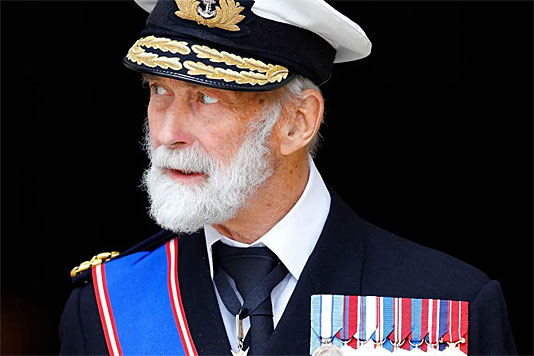
Anne, the Princess Royal
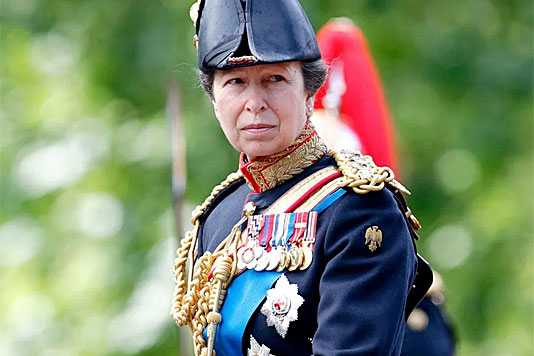
Princess Anne never did service in the military but holds a number of honours and titles. The outfit that she wears on special occasions is a Royal Navy ceremonial uniform to represent her role in that division of the army.
Anne is committed to her military causes and was made Rear Admiral in 1993, then Vice Admiral in 2009 and Admiral in 2012.
In 2020, the Princess Royal was made a General in the British Army, and an Air Chief Marshal in the Royal Air Force.
The Princess currently has the following medals: Queen’s Service Order, Queen Elizabeth II Coronation medal, Silver Jubilee medal, Golden Jubilee medal, Diamond Jubilee medal, Platinum Jubilee medal, Naval Long Service and Good Conduct medal, Canadian Forces Decoration, Order of St John Service medal, New Zealand Commemorative medal, Order of the Garter and/ or Order of the Thistle and Royal Victorian Order.
Anne is committed to her military causes and was made Rear Admiral in 1993, then Vice Admiral in 2009 and Admiral in 2012.
In 2020, the Princess Royal was made a General in the British Army, and an Air Chief Marshal in the Royal Air Force.
The Princess currently has the following medals: Queen’s Service Order, Queen Elizabeth II Coronation medal, Silver Jubilee medal, Golden Jubilee medal, Diamond Jubilee medal, Platinum Jubilee medal, Naval Long Service and Good Conduct medal, Canadian Forces Decoration, Order of St John Service medal, New Zealand Commemorative medal, Order of the Garter and/ or Order of the Thistle and Royal Victorian Order.

A new member joining us recently is:
Martin Matthews, Leicester
Welcome to the OBA!

From: Andrew Davies
Subject: Tony Davies
Hi Tony,
I just wanted to let you that my father, Tony Davies, UKMAMS F Team, RAF Abingdon, 1967-69, passed away today, 7th November, 2024.
Unfortunately he was nearly blind in his last few years, but always enjoyed the experience and memories that l would read to him. His face would light up when a familiar name was mentioned; David Powell was one and he would often talk about his time on UKMAMS being hard work but enjoyable. As he put it... he learnt about movements on MAMS which helped him later when he left the RAF and joined the Oman Air Force and was DAMO at RAFO SEEB and RAFO Masirah in Oman - Happy times.
As an ex-Fleet Air Arm RN Petty Officer myself, l have also enjoyed the stories and if possible would like to continue receiving them please. The last story l told him was the one about the parachute cats which bought a smile to his face.
Thanks again for all your hard work and bringing joy and happy memories to my late father, especially in his last 6 months, which were a struggle.
Kind regards, Andrew Davies
Subject: Tony Davies
Hi Tony,
I just wanted to let you that my father, Tony Davies, UKMAMS F Team, RAF Abingdon, 1967-69, passed away today, 7th November, 2024.
Unfortunately he was nearly blind in his last few years, but always enjoyed the experience and memories that l would read to him. His face would light up when a familiar name was mentioned; David Powell was one and he would often talk about his time on UKMAMS being hard work but enjoyable. As he put it... he learnt about movements on MAMS which helped him later when he left the RAF and joined the Oman Air Force and was DAMO at RAFO SEEB and RAFO Masirah in Oman - Happy times.
As an ex-Fleet Air Arm RN Petty Officer myself, l have also enjoyed the stories and if possible would like to continue receiving them please. The last story l told him was the one about the parachute cats which bought a smile to his face.
Thanks again for all your hard work and bringing joy and happy memories to my late father, especially in his last 6 months, which were a struggle.
Kind regards, Andrew Davies
From: Tony Gale, Gatineau, QC
Dear Andrew,
My heartfelt condolences to you and your family on the passing of your father.
I remember Tony with fondness, as I myself was posted onto F team RAF Abingdon as a Senior Aircraftsman in late 1968. In those early days of the squadron there were no “Health and Safety” boundaries to keep us in check and we were pretty much left to our own devices to get the aircraft off chocks on time. As your father mentioned, it was hard work but enjoyable. Never knowing where in the world we would be tomorrow made being a member of UKMAMS a unique experience and built a camaraderie that would last a lifetime.
Sincerely,
Tony Gale
Dear Andrew,
My heartfelt condolences to you and your family on the passing of your father.
I remember Tony with fondness, as I myself was posted onto F team RAF Abingdon as a Senior Aircraftsman in late 1968. In those early days of the squadron there were no “Health and Safety” boundaries to keep us in check and we were pretty much left to our own devices to get the aircraft off chocks on time. As your father mentioned, it was hard work but enjoyable. Never knowing where in the world we would be tomorrow made being a member of UKMAMS a unique experience and built a camaraderie that would last a lifetime.
Sincerely,
Tony Gale
From: David Powell, Princes Risborough, Bucks
Hello Andrew,
I am so sorry to learn of the passing of your father and my sincere condolences to you and the family at this time.
I was touched to learn that Tony was able to enjoy sharing some of my ramblings of the magic time we had with F Team at Abingdon and then (1971) with the Gulf MAMF.
I was lucky to then go on to have some 30 years in blue in 17 or more roles, most, if not quite all, fun, always interesting, some bordering on exciting, before exploring new civilian worlds which had, in some cases still have, a means of having fun as well as supplementing retired pay. However, it was the all too short time that I had with F Team that was the icing on the cake. And, it was working with people like Tony Gale and your father which made that time most special.
Yours sincerely,
David Powell
Hello Andrew,
I am so sorry to learn of the passing of your father and my sincere condolences to you and the family at this time.
I was touched to learn that Tony was able to enjoy sharing some of my ramblings of the magic time we had with F Team at Abingdon and then (1971) with the Gulf MAMF.
I was lucky to then go on to have some 30 years in blue in 17 or more roles, most, if not quite all, fun, always interesting, some bordering on exciting, before exploring new civilian worlds which had, in some cases still have, a means of having fun as well as supplementing retired pay. However, it was the all too short time that I had with F Team that was the icing on the cake. And, it was working with people like Tony Gale and your father which made that time most special.
Yours sincerely,
David Powell

Tony Davies - Long Service in Two Air Forces
By Andrew Davies
By Andrew Davies
Early life
This is the tale of a lad from Liverpool who saw the world and earned an interesting group of medals along the way. My father, Anthony (Tony) Davies, was a flight sergeant in the Royal Air Force and a warrant officer in the Royal Air Force of Oman, and earned long service medals in both.
Born in Liverpool in 1936 and moving to the village of Parbold aged four, Tony remembers seeing and visiting Liverpool during their Blitz. Leaving school at age 15 and gaining employment in a small café, it was going to be only a short while before HM forces requested the pleasure of his company for national service. Tony beat them to it in 1954 when, always having had an interest in aircraft and flight and not wishing to go into the Army or Navy, he volunteered for three years in the Royal Air Force.
This is the tale of a lad from Liverpool who saw the world and earned an interesting group of medals along the way. My father, Anthony (Tony) Davies, was a flight sergeant in the Royal Air Force and a warrant officer in the Royal Air Force of Oman, and earned long service medals in both.
Born in Liverpool in 1936 and moving to the village of Parbold aged four, Tony remembers seeing and visiting Liverpool during their Blitz. Leaving school at age 15 and gaining employment in a small café, it was going to be only a short while before HM forces requested the pleasure of his company for national service. Tony beat them to it in 1954 when, always having had an interest in aircraft and flight and not wishing to go into the Army or Navy, he volunteered for three years in the Royal Air Force.
Tony reported to RAF Cardington which had once been home to the R100/101 airships. His aspirations to become an air gunner were, however, short-lived once the RAF found out about his previous cooking experience.
Having completed a cookery test he was advanced to AC1 (aircraftman 1st class) and sent to RAF West Kirby for initial training and square bashing. [Photo at left: The then AC1 Tony Davies (middle row, centre) at the time of his basic entry course in 1954].
Following a stint at RAF Medmenham as relief cook for the AOC (air officer commanding) 90 Group (Signals Command), he was offered a post as cook for the AOC 41 Group (Maintenance Command) cooking for both Air Vice Marshal A. Opie and Air Vice Marshal R.G. Hart, CBE, OBE, MC at Thruxton Manor, RAF Amport.
It was here that he had his first flight in an Avro Anson which the AOC sent down with his personal pilot to pick him up. During this flight Tony was required to help lower the undercarriage by vigorous turning of a handle. Unfortunately this was as near as he got to an aeroplane for the next three years. During this time Tony was promoted to corporal and, upon completing his three years’ service, left the RAF in 1957.
Now married, he spent a tough year in civvy street, working in various hotel and cooking jobs.
Having completed a cookery test he was advanced to AC1 (aircraftman 1st class) and sent to RAF West Kirby for initial training and square bashing. [Photo at left: The then AC1 Tony Davies (middle row, centre) at the time of his basic entry course in 1954].
Following a stint at RAF Medmenham as relief cook for the AOC (air officer commanding) 90 Group (Signals Command), he was offered a post as cook for the AOC 41 Group (Maintenance Command) cooking for both Air Vice Marshal A. Opie and Air Vice Marshal R.G. Hart, CBE, OBE, MC at Thruxton Manor, RAF Amport.
It was here that he had his first flight in an Avro Anson which the AOC sent down with his personal pilot to pick him up. During this flight Tony was required to help lower the undercarriage by vigorous turning of a handle. Unfortunately this was as near as he got to an aeroplane for the next three years. During this time Tony was promoted to corporal and, upon completing his three years’ service, left the RAF in 1957.
Now married, he spent a tough year in civvy street, working in various hotel and cooking jobs.
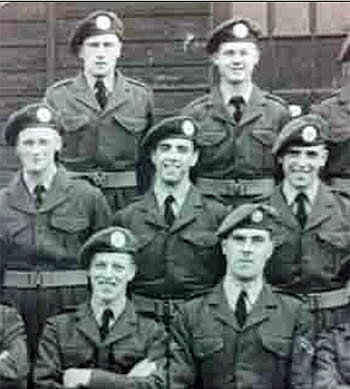
Re-enlistment
Tony re-enlisted into the RAF in 1958 with the same rank and was posted to RAF Hospital Wroughton, working again for the same AOC of 41 Group. This was followed by a short spell at RAF Andover before he was posted to Malta, where he worked in the kitchens of RAF Luqa and Takalia. Malta at this time still had some rationing, including an ice ration for people without a fridge, but the climate and kindness of the Maltese people more than made up for this.
Returning in 1961 to the UK and the transit mess at RAF Lynham, Tony changed trade to stores. He completed his training at Kirton Linsey, followed by a posting in 1963 as forward delivery driver to Bomber Command Strategic School at RAF Feltwell. This involved driving and delivering stores to all the Thor Ballistic Missile sites in Norfolk. Posted to RAF St Mawgan in 1964 and the petrol/oil/lubricants section, Tony had another fated encounter with an aircraft. Travelling to work one day on his Vespa scooter he came close to an aircraft again when he was blown over by the propeller wash from a taxiing Avro Shackleton. Perhaps he took this as a sign as 1965 saw him attend the movements course at RAF Abingdon, this being the pathway to air movements and getting to work on aircraft.
Tony re-enlisted into the RAF in 1958 with the same rank and was posted to RAF Hospital Wroughton, working again for the same AOC of 41 Group. This was followed by a short spell at RAF Andover before he was posted to Malta, where he worked in the kitchens of RAF Luqa and Takalia. Malta at this time still had some rationing, including an ice ration for people without a fridge, but the climate and kindness of the Maltese people more than made up for this.
Returning in 1961 to the UK and the transit mess at RAF Lynham, Tony changed trade to stores. He completed his training at Kirton Linsey, followed by a posting in 1963 as forward delivery driver to Bomber Command Strategic School at RAF Feltwell. This involved driving and delivering stores to all the Thor Ballistic Missile sites in Norfolk. Posted to RAF St Mawgan in 1964 and the petrol/oil/lubricants section, Tony had another fated encounter with an aircraft. Travelling to work one day on his Vespa scooter he came close to an aircraft again when he was blown over by the propeller wash from a taxiing Avro Shackleton. Perhaps he took this as a sign as 1965 saw him attend the movements course at RAF Abingdon, this being the pathway to air movements and getting to work on aircraft.
Airborne at last
Tony was posted to Cyprus in 1965 just as the EOKA terrorist troubles were finishing. The family remained in the safety of England but joined him three months later. He spent a few months in stores at RAF Akrotiri and with promotion to sergeant went to the Air Booking Centre at RAF Episkopi. After two years he returned to RAF Akrotiri and the movements section. It was here after nearly 10 years in the RAF that he finally got to work on aircraft dealing with passengers and freight on a variety of aircraft including Comets, Britannias, VC10s, Hastings, Argosies and Andovers. The station also housed NEAF (Near East Air Force) Vulcans and assorted fighters on summer camp. In Cyprus at the same time was Air Vice Marshal Harold (Micky) Martin of ‘Dambuster’ fame and as a young boy I can recall going with my father to a presentation and talk about the Dambusters given by Air Vice Marshal Martin.
Tony returned home to the UK and RAF Abingdon where on the toss of a coin he joined the UKMAMS (United Kingdom Mobile Air Movements Squadron). It was here that he really learnt about air movements, flying around the world sometimes at a moment’s notice (normally in the middle of the night) in support of various operations. These included the peaceful uprising in Anguilla in 1969, where the only loud noise was that of the steel bands; large-scale exercises in the jungles of the Far East or the Arctic snow in Norway; plus numerous troop reinforcements to Northern Ireland during the troubles. These involved flying into, and operating from, RAF Aldergrove and would involve a large number of flights daily from the UK and RAF Germany to the province depending on the size of the reinforcements. Tony recalls that during one such operation to Northern Ireland they worked continually for nearly 24 hours as reinforcements poured in.
He, like many UKMAM’s personnel and others, did more than 28 days in and out of the troubled province but did not qualify for the ‘NORTHERN IRELAND’ clasp to the General Service Medal 1962-2003 as it was not continuous service. He was also involved in the withdrawal from RAF El Adam in Libya and took part in the last round-the-world flight of Coastal Command Shackletons, when he flew with the support team in the luxury of a Transport Command Britannia – normally they flew in the back of freight aircraft such as a C130 or Argosy.
In the early 1970s Tony flew in and out of the various airfields in the Gulf region including RAF Masirah, RAF Muharraq and RAF Salalah where, on landing, the aircraft were surrounded by mobile oil drum revetments as the Dhofar emergency and shelling from Yemen was still active. Little did he realise that a few short years later he would be back in the Gulf.
Tony was posted to Cyprus in 1965 just as the EOKA terrorist troubles were finishing. The family remained in the safety of England but joined him three months later. He spent a few months in stores at RAF Akrotiri and with promotion to sergeant went to the Air Booking Centre at RAF Episkopi. After two years he returned to RAF Akrotiri and the movements section. It was here after nearly 10 years in the RAF that he finally got to work on aircraft dealing with passengers and freight on a variety of aircraft including Comets, Britannias, VC10s, Hastings, Argosies and Andovers. The station also housed NEAF (Near East Air Force) Vulcans and assorted fighters on summer camp. In Cyprus at the same time was Air Vice Marshal Harold (Micky) Martin of ‘Dambuster’ fame and as a young boy I can recall going with my father to a presentation and talk about the Dambusters given by Air Vice Marshal Martin.
Tony returned home to the UK and RAF Abingdon where on the toss of a coin he joined the UKMAMS (United Kingdom Mobile Air Movements Squadron). It was here that he really learnt about air movements, flying around the world sometimes at a moment’s notice (normally in the middle of the night) in support of various operations. These included the peaceful uprising in Anguilla in 1969, where the only loud noise was that of the steel bands; large-scale exercises in the jungles of the Far East or the Arctic snow in Norway; plus numerous troop reinforcements to Northern Ireland during the troubles. These involved flying into, and operating from, RAF Aldergrove and would involve a large number of flights daily from the UK and RAF Germany to the province depending on the size of the reinforcements. Tony recalls that during one such operation to Northern Ireland they worked continually for nearly 24 hours as reinforcements poured in.
He, like many UKMAM’s personnel and others, did more than 28 days in and out of the troubled province but did not qualify for the ‘NORTHERN IRELAND’ clasp to the General Service Medal 1962-2003 as it was not continuous service. He was also involved in the withdrawal from RAF El Adam in Libya and took part in the last round-the-world flight of Coastal Command Shackletons, when he flew with the support team in the luxury of a Transport Command Britannia – normally they flew in the back of freight aircraft such as a C130 or Argosy.
In the early 1970s Tony flew in and out of the various airfields in the Gulf region including RAF Masirah, RAF Muharraq and RAF Salalah where, on landing, the aircraft were surrounded by mobile oil drum revetments as the Dhofar emergency and shelling from Yemen was still active. Little did he realise that a few short years later he would be back in the Gulf.
The Far East
Leaving UKMAMs after a very busy two years he was posted to Hong Kong and RAF Kai Tak as movements shift sergeant working both at the military and civil side of the airport. During this period, Gurkha personnel were regularly rotated back through Hong Kong to Nepal, and it was here that he met Rambahadur Limbu, VC. Promotion to flight sergeant was followed shortly after by the award of his RAF Long Service and Good Conduct Medal (LSGC) which was presented in the station commander’s office. Soon after he returned to the UK and RAF Hendon (London), looking after service personnel and families that were returning on compassionate flights from all over the world via Heathrow Airport.
After just six months in the UK he returned to the Far East in January 1975 as flight sergeant movements at the RAF Support Unit Tengah, Singapore. This was part of the ANZUK Force (Australia New Zealand United Kingdom).
Leaving UKMAMs after a very busy two years he was posted to Hong Kong and RAF Kai Tak as movements shift sergeant working both at the military and civil side of the airport. During this period, Gurkha personnel were regularly rotated back through Hong Kong to Nepal, and it was here that he met Rambahadur Limbu, VC. Promotion to flight sergeant was followed shortly after by the award of his RAF Long Service and Good Conduct Medal (LSGC) which was presented in the station commander’s office. Soon after he returned to the UK and RAF Hendon (London), looking after service personnel and families that were returning on compassionate flights from all over the world via Heathrow Airport.
After just six months in the UK he returned to the Far East in January 1975 as flight sergeant movements at the RAF Support Unit Tengah, Singapore. This was part of the ANZUK Force (Australia New Zealand United Kingdom).
During the final weeks of the Vietnam War and the collapse of Saigon, because of his UKMAMS' experience, Tony flew into Tan San Not airfield in South Vietnam to help with the evacuation of personnel from the British Embassy in Saigon. This involved the RAF C130 Hercules doing a very steep spiral tactical approach/departure as the North Vietnamese were very close to the outskirts and approaching the city itself. He remembers seeing tanks and burning buildings in the surrounding countryside. Saigon fell soon after. [Photo at right: Tan San Not, Saigon – F/Sgt Davies is second from left.]
During his time in Singapore he had the privilege of working on some classic aircraft courtesy of the RAAF – Dakota DC3s and the RNZAF Bristol Freighters B170 similar to those of Silver City Airways fame from the 1950s.
Following a change of government in the UK and withdrawal from ‘East of Suez’, RAF Singapore was closed and British forces withdrawn. Tony and the family departed from tropical Changi nearly a year to the day after we had arrived, on one of the last RAF passenger aircraft to leave Singapore. Returning to a snow-covered UK and RAF Brize Norton.
Tony left the RAF 12 months later after 22 years’ service. During his time he had seen many places around the world, witnessed the dismantling of Empire and the closure of respective overseas bases – not bad for a lad from Liverpool. His single LSGC, like those of many servicemen of his time and generation, reflects only a small part of his service and untold stories.
During his time in Singapore he had the privilege of working on some classic aircraft courtesy of the RAAF – Dakota DC3s and the RNZAF Bristol Freighters B170 similar to those of Silver City Airways fame from the 1950s.
Following a change of government in the UK and withdrawal from ‘East of Suez’, RAF Singapore was closed and British forces withdrawn. Tony and the family departed from tropical Changi nearly a year to the day after we had arrived, on one of the last RAF passenger aircraft to leave Singapore. Returning to a snow-covered UK and RAF Brize Norton.
Tony left the RAF 12 months later after 22 years’ service. During his time he had seen many places around the world, witnessed the dismantling of Empire and the closure of respective overseas bases – not bad for a lad from Liverpool. His single LSGC, like those of many servicemen of his time and generation, reflects only a small part of his service and untold stories.
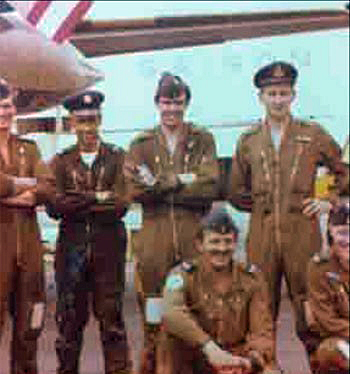
Royal Air Force of Oman
After doing a few odd jobs in the Plymouth area, an advert for a sergeant movements instructor in Oman caught his eye. After successfully applying he arrived in the Sultanate of Oman in 1978 to be greeted at Seeb airport by a former corporal whom he had worked with in the RAF. Sultanate of Oman Air Force (SOAF) at that time, along with the civilian contractor Airworks, employed many ex-service personnel both as contractors and uniformed officers, many of whom held the GSM 1962-2007 for Radfan, South Arabia and Dhofar. SOAF also employed many ex-RAF ‘retired pilots’ with a couple of Air Force Crosses and assorted campaign medals amongst them.
Tony’s induction and orientation was carried out at the whitewashed Fort Bait Al Falajah, a building straight out of Beau Geste. This is now the armed forces of Oman museum. Initially working at SOAF HQ, on promotion to flight sergeant in 1979 he was posted to the former RAF base on the island of Masirah. Here the RAF station name board and crest was still standing with the words SOAF painted over the part that previously read RAF. There were also the remains of the narrow-gauge Masirah state railway which had been used by the RAF to transport stores from the harbour jetty to the camp. The engine and part of the track were returned to the RAF Museum at Cosford and are now on loan to a heritage steam railway in the UK.
After doing a few odd jobs in the Plymouth area, an advert for a sergeant movements instructor in Oman caught his eye. After successfully applying he arrived in the Sultanate of Oman in 1978 to be greeted at Seeb airport by a former corporal whom he had worked with in the RAF. Sultanate of Oman Air Force (SOAF) at that time, along with the civilian contractor Airworks, employed many ex-service personnel both as contractors and uniformed officers, many of whom held the GSM 1962-2007 for Radfan, South Arabia and Dhofar. SOAF also employed many ex-RAF ‘retired pilots’ with a couple of Air Force Crosses and assorted campaign medals amongst them.
Tony’s induction and orientation was carried out at the whitewashed Fort Bait Al Falajah, a building straight out of Beau Geste. This is now the armed forces of Oman museum. Initially working at SOAF HQ, on promotion to flight sergeant in 1979 he was posted to the former RAF base on the island of Masirah. Here the RAF station name board and crest was still standing with the words SOAF painted over the part that previously read RAF. There were also the remains of the narrow-gauge Masirah state railway which had been used by the RAF to transport stores from the harbour jetty to the camp. The engine and part of the track were returned to the RAF Museum at Cosford and are now on loan to a heritage steam railway in the UK.
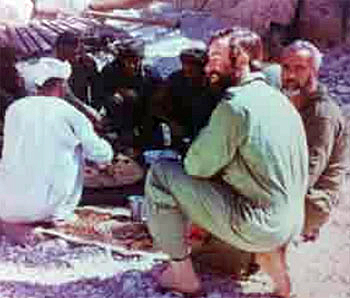
Of the many jobs Tony undertook in Oman, one of his favourites was flying in support of the civil aid programmes. This involved underslung load lifting of building supplies and transporting anything from flour, goats and chickens in the back of helicopters up into the mountains for the local Omani population. [Photo at left: Break for lunch during operations to provide civil aid in Oman. F/Sgt Davies is far right]
He was also involved in transportation of various exotic animals including for the Arabian Oryx breeding programme in the back of SOAF C130 Hercules aircraft. In 1980 he was awarded the Oman Peace Medal, which was awarded to all Omani and uniformed contract officers for completion of one years’ service since 1976.
Over the next 14 years Tony was promoted to warrant officer class 2 and then warrant officer class1, becoming the DAMO (Duty Air Movements Officer) both at SOAF Marsiah and SOAF Seeb. In 1980 he was awarded the 10 Year Accession Anniversary Medal, followed in 1985 by the 15 Year Accession Anniversary Medal.
He was also involved in transportation of various exotic animals including for the Arabian Oryx breeding programme in the back of SOAF C130 Hercules aircraft. In 1980 he was awarded the Oman Peace Medal, which was awarded to all Omani and uniformed contract officers for completion of one years’ service since 1976.
Over the next 14 years Tony was promoted to warrant officer class 2 and then warrant officer class1, becoming the DAMO (Duty Air Movements Officer) both at SOAF Marsiah and SOAF Seeb. In 1980 he was awarded the 10 Year Accession Anniversary Medal, followed in 1985 by the 15 Year Accession Anniversary Medal.
In 1990 the SOAF was renamed the Royal Air Force of Oman (RAFO). After a varied and enjoyable 12 years he finally did the job he had initially been employed for and became the RAFO senior movements instructor, teaching Omani officers and airmen. Following the liberation of Kuwait in the 1990 Gulf War he was part of the movements team that flew into the devastated Kuwait City airport to bring Omani troops home. During 1990 he received both the Oman 20 Year Accession Anniversary Medal and the Omani Forces LSGC. The latter was awarded for 12 years’ service. It was presented to Tony by the Commander, Royal Air Force of Oman, Air Vice Marshal Al Liwa Talib Meran, at a special parade for expatriate officers and senior NCOs.
[Photo at right: The medals awarded to Tony Davies for almost four decades of service. From left, Oman Peace Medal 1975; Omani 10, 15 and 20 Year Accession Anniversary Medals; Oman Forces LSGC; RAF LSGC]
[Photo at right: The medals awarded to Tony Davies for almost four decades of service. From left, Oman Peace Medal 1975; Omani 10, 15 and 20 Year Accession Anniversary Medals; Oman Forces LSGC; RAF LSGC]
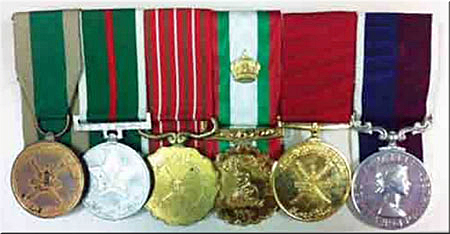
Tony finally retired from Oman and the air force way of life after he had spent the best part of nearly 37 years in uniform, from airman to warrant officer, being awarded long service medals in both the Royal Air Force and Royal Air Force of Oman. Now retired, he lives in Australia.
Originally published in OBB #073115
Originally published in OBB #073115

And so, another year is coming to a close and thoughts are gravitating towards Christmas and family gatherings.
But let's not forget all the friends we have made over the years, especially in the Movements world. Here's your opportunity to send greetings to a great number of them at one fell swoop!
The Christmas and New Year edition of the OBA newsletter is scheduled to be published on Monday 30th December, with a cut-off for submissions on Saturday 28th.
This year's format will be similar to previous recent years and as an aide mémoire here is the edition from December 2022 (I was travelling in December 2023, so there wasn't one last year): https://ukmamsoba.org/obb123022.html
Just a couple of lines will do it - and if you have a photograph to share, then all the better!
I anticipate that there will be hundreds of e-mails to be processed, so the earlier you get your greetings in, the easier it will be for me.
But let's not forget all the friends we have made over the years, especially in the Movements world. Here's your opportunity to send greetings to a great number of them at one fell swoop!
The Christmas and New Year edition of the OBA newsletter is scheduled to be published on Monday 30th December, with a cut-off for submissions on Saturday 28th.
This year's format will be similar to previous recent years and as an aide mémoire here is the edition from December 2022 (I was travelling in December 2023, so there wasn't one last year): https://ukmamsoba.org/obb123022.html
Just a couple of lines will do it - and if you have a photograph to share, then all the better!
I anticipate that there will be hundreds of e-mails to be processed, so the earlier you get your greetings in, the easier it will be for me.
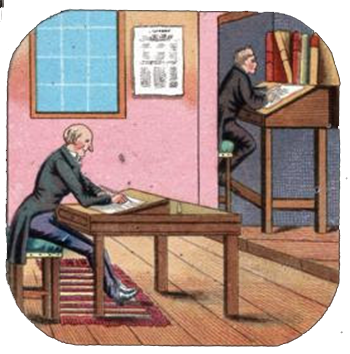
This Newsletter is Dedicated
to the Memories of:
Trevor Jenner (RAF)
Alan Kilpatrick (RAF)
Gavin Robert (RNZAF)
Richard Davidson (RAF)
Tony Davies (RAF/RAFO)
Kane Edmonstone (RCAF)
George (Gerry) Davis (RAF)
Rhonda Lee Castonguay (RCAF)
to the Memories of:
Trevor Jenner (RAF)
Alan Kilpatrick (RAF)
Gavin Robert (RNZAF)
Richard Davidson (RAF)
Tony Davies (RAF/RAFO)
Kane Edmonstone (RCAF)
George (Gerry) Davis (RAF)
Rhonda Lee Castonguay (RCAF)
Tony Gale
ukmamsoba@gmail.com
ukmamsoba@gmail.com
